SCHEME OF WORK
WEEKS TOPICS
1. Revision of second term work: Office Practice
2. Office procedure:(a) meaning and importance of office procedure (b)procedures for preparing bills, invoice and receipts.(i)Computer software (ii)Typewriter(iii)Adding machines.(c)procedures for making payments by: (i) cash (ii) bank transfer (iii) cheque (iv) bank draft
3. Office procedure:(d)imprest Account: (i) Balance and restoration of imprest.(e)The role of wages and salaries unit:-preparation of vouchers,payroll and pay slip advice (f)Store records:-meaning of store,meaning of store records,procedure for store procurement(use of store requisition ) (g) Delivery note and gate pass.
4. Office Equipment:(a)Meaning of office equipment.(b)Identification of office equipment (c)Types of office equipment (d) Importance and uses of office equipment (e)Care of office equipment.
5. Advertising:(a)Meaning of advertising,Types of advertising,functions of advertising (b) Forms of advertising media:- Radio,Television,Newspaper,Magazines,Handbills,Internet,Bill Boards,etc (c)Advertising ethics.
6. Transportation :(a) Meaning of transportation (b)Importance of transportation in commerce (c) Types of transportation:-Road,Air,Rail,Water,pipeline.
7. Transportation :(d) Advantages and disadvantages of each type of transportation.
8. Communication :(a) meaning of communication. Means of communication-post, telephone, world wide web, courier services.(b) importance of communication in business.
9. Communication :(c)Services provided by communication agencies: Post and Telegraph services, Telephone services, internet, courier services.
10. WAGES AND SALARIES (Revision) Role of wages department
11. STORE RECORDS (Revision) Role of wages department
12. ADVERTISING (Revision) Role of wages department
13. TRANSPORTATION (Revision) Role of wages department
14. COMMUNICATION (Revision) Role of wages department
15. Revision.
1ST TERM
WEEK 1
LESSON 1
MAIN TOPIC: REVISION/ OFFICE PRACTICE
SPECIFIC TOPIC: Revision/ Meaning of office practice
REFERENCE BOOKS:
Macmillan JSS3 Business Studies by Awoyokun A.A et al .Pages 1-5
WABP JSS Business Studies 3 by Egbe T. Ehiametalor. Pages 3-6
Spectrum Business Study for JSS3 by Eno L. Inanga and Ebun C.Ojo. Pages 4-7
PERFORMANCE OBJECTIVES: At the end of the lesson, students should be able to:
explain the meaning of office procedure
list the importance of office procedure
differentiate between the different types of bills
CONTENTS:
An office procedure can be defined as the sequence in which certain operations are carried out in respect of what is done, how it is done who does it and where it is done in the organisation.
It is the method of performing office functions so as to achieve maximum office efficiency.
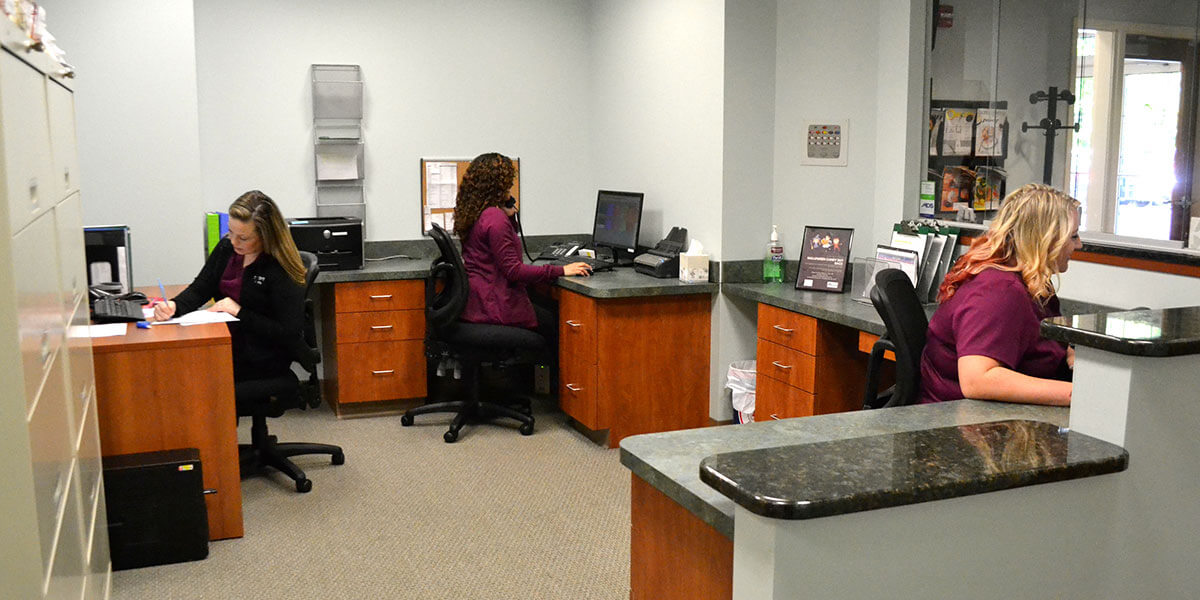
IMPORTANCE OF OFFICE PROCEDURE
It facilitates better flow of work in the office and between departments
It allows for better co-ordination of activities between offices and between different departments of an organisation
It allows for effective training of new staff and enhances effective performance of old staff.
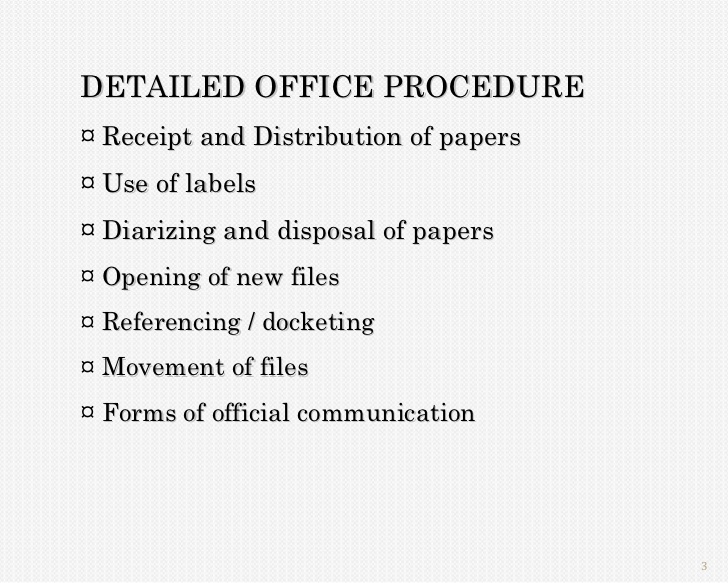
BILLS: There are three main types of bill and they are:
Due bill
Bill of laden
Bill of exchange
EVALUATION:
What is office procedure?
Mention three importance of office procedure
Differentiate between due bill and bill of laden.
HOME-WORK: Mention three procedures for preparing bills and invoice
further studies
http://www.slideshare.net/ShahidAli13/o ... -practices
LESSON 2
MAIN TOPIC: OFFICE PRACTICE
SPECIFIC TOPIC: Procedure for preparing bills and invoices
REFERENCE BOOKS:
Macmillan JSS3 Business Studies by Awoyokun A.A et al .Pages 1-5
WABP JSS Business Studies 3 by Egbe T. Ehiametalor. Pages 3-6
Spectrum Business Study for JSS3 by Eno L. Inanga and Ebun C.Ojo. Pages 4-7
PERFORMANCE OBJECTIVES: At the end of the lesson, students should be able to:
explain the procedure for preparing bills and invoices
CONTENTS:
PROCEDURES FOR PREPARING BILLS AND INVOICE
There are many mechanized procedures used in speeding up the preparation of bills or invoices. They are:
Typewriter
Typewriter or calculator adaptation
The adding machine adaptation
The cash register adaptation
The photocopy technique
EVALUATION:
Mention five procedure for preparing bills and invoices
HOME-WORK: Mention three procedures for making payment.
Further Studies
Prepare a sample Customer Invoice
LESSON 3
MAIN TOPIC: OFFICE PRACTICE
SPECIFIC TOPIC: Procedure for preparing bills and invoices
REFERENCE BOOKS:
Macmillan JSS3 Business Studies by Awoyokun A.A et al .Pages 1-5
WABP JSS Business Studies 3 by Egbe T. Ehiametalor. Pages 3-6
Spectrum Business Study for JSS3 by Eno L. Inanga and Ebun C.Ojo. Pages 4-7
PERFORMANCE OBJECTIVES: At the end of the lesson, students should be able to:
explain the procedure for making payments
CONTENTS:
There are numerous ways that can be used to make payment for goods bought or services rendered. They are:
Payment by cash
Payment by cheque
Payment by bank draft
Payment by credit cards
Payment by traveller's cheque (BTA,PTA)
Payment through the post office
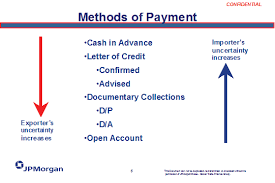
EVALUATION:
What is a credit card?
What is a travelers cheque
mention two means of making payments through the post office
HOME-WORK: Mention five role of wages department
MAIN TOPIC: REVISION/ OFFICE PRACTICE
SPECIFIC TOPIC: Revision/ Meaning of office practice
REFERENCE BOOKS:
Macmillan JSS3 Business Studies by Awoyokun A.A et al .Pages 1-5
WABP JSS Business Studies 3 by Egbe T. Ehiametalor. Pages 3-6
Spectrum Business Study for JSS3 by Eno L. Inanga and Ebun C.Ojo. Pages 4-7
PERFORMANCE OBJECTIVES: At the end of the lesson, students should be able to:
explain the meaning of office procedure
list the importance of office procedure
differentiate between the different types of bills
CONTENTS:
An office procedure can be defined as the sequence in which certain operations are carried out in respect of what is done, how it is done who does it and where it is done in the organisation.
It is the method of performing office functions so as to achieve maximum office efficiency.

IMPORTANCE OF OFFICE PROCEDURE
It facilitates better flow of work in the office and between departments
It allows for better co-ordination of activities between offices and between different departments of an organisation
It allows for effective training of new staff and enhances effective performance of old staff.

BILLS: There are three main types of bill and they are:
Due bill
Bill of laden
Bill of exchange
EVALUATION:
What is office procedure?
Mention three importance of office procedure
Differentiate between due bill and bill of laden.
HOME-WORK: Mention three procedures for preparing bills and invoice
further studies
http://www.slideshare.net/ShahidAli13/o ... -practices
LESSON 2
MAIN TOPIC: OFFICE PRACTICE
SPECIFIC TOPIC: Procedure for preparing bills and invoices
REFERENCE BOOKS:
Macmillan JSS3 Business Studies by Awoyokun A.A et al .Pages 1-5
WABP JSS Business Studies 3 by Egbe T. Ehiametalor. Pages 3-6
Spectrum Business Study for JSS3 by Eno L. Inanga and Ebun C.Ojo. Pages 4-7
PERFORMANCE OBJECTIVES: At the end of the lesson, students should be able to:
explain the procedure for preparing bills and invoices
CONTENTS:
PROCEDURES FOR PREPARING BILLS AND INVOICE
There are many mechanized procedures used in speeding up the preparation of bills or invoices. They are:
Typewriter
Typewriter or calculator adaptation
The adding machine adaptation
The cash register adaptation
The photocopy technique
EVALUATION:
Mention five procedure for preparing bills and invoices
HOME-WORK: Mention three procedures for making payment.
Further Studies
Prepare a sample Customer Invoice
LESSON 3
MAIN TOPIC: OFFICE PRACTICE
SPECIFIC TOPIC: Procedure for preparing bills and invoices
REFERENCE BOOKS:
Macmillan JSS3 Business Studies by Awoyokun A.A et al .Pages 1-5
WABP JSS Business Studies 3 by Egbe T. Ehiametalor. Pages 3-6
Spectrum Business Study for JSS3 by Eno L. Inanga and Ebun C.Ojo. Pages 4-7
PERFORMANCE OBJECTIVES: At the end of the lesson, students should be able to:
explain the procedure for making payments
CONTENTS:
There are numerous ways that can be used to make payment for goods bought or services rendered. They are:
Payment by cash
Payment by cheque
Payment by bank draft
Payment by credit cards
Payment by traveller's cheque (BTA,PTA)
Payment through the post office

EVALUATION:
What is a credit card?
What is a travelers cheque
mention two means of making payments through the post office
HOME-WORK: Mention five role of wages department
WEEK 2
LESSON 4
Topic: OFFICE PROCEDURE
CONTENT: (i) Meaning and importance of office procedure
(ii) Procedures for preparing bills, invoice and receipts
(iii) Computer software, Typewriter, Adding machines
(iv) Procedures for making payments by: cash, bank transfer, cheque,
and bank draft.
MEANING AND IMPORTANCE OF OFFICE PROCEDURE
MEANING OF OFFICE PROCEDURE:
It is a set of rules or policies guiding the operations of an office. Office procedures set the standard for how staff works together in the office.

IMPORTANCE OF OFFICE PROCEDURE:
1. It ensures efficient running of an office.
2. Office procedures create a uniform way of doing things, that is,
Consistency, efficiency and professionalism within the office environment.
3. Office procedure instills disciple in an organisation (e.g no personal phone
calls, checking voice mail in the mornings, no unnecessary conversations with
Clients etc).
4. It helps us to know how to handle both incoming and outgoing mails.
5. It makes for an organized office environment
6. It helps office workers to understand their various assigned duties.
PROCEDURE FOR PREPARING SOME OF THE DOCUMENTS USED IN THE OFFICE
Service Bill: Companies which provide specialized services use service bills as demands for payment.
In Nigeria, PHCN and Nigerian Water Corporation two organizations well-known for using service bills as demands for payments.Usually, service bills are sent to customers on a monthly basis, and the bills show current charges, where payment is to be made as well as rental charges, if any.
Invoice:
This is a document sent by the seller to a buyer showing the description, quantity, price of goods bought.In everyday business transactions, when a buyer buys goods from a seller, the seller issues an invoice which outlines the following details:
i) Order number and date
ii) Quantity and description of goods bought
iii) Unit price
iv) Total price
v) Net amount payable
vi) Terms of delivery
The main purpose of an invoice is to outline the customer`s extent of indebtedness to the supplier.

Purpose of an invoice:
1. When used as a proforma invoice, an invoice is sent as a receipt for an order.
2. An invoice can be used to inform the warehouse about the types of goods to be withdrawn from the stock.
3. An invoice can be used to inform the wholesaler about goods to be produced or supplied.
4. An invoice can be used as an advice note to the transport department
5. An invoice can serve as a delivery note, when used to identify the goods dispatched.
6. An invoice enables the accounts department to know the amount to collect from the customer.
Pro forma invoice
This is a type of invoice sent in advance of goods, to show that the goods are being dispatched and what amount will feature on the invoice proper. A pro forma invoice is prepared by the seller and sent to the buyer.
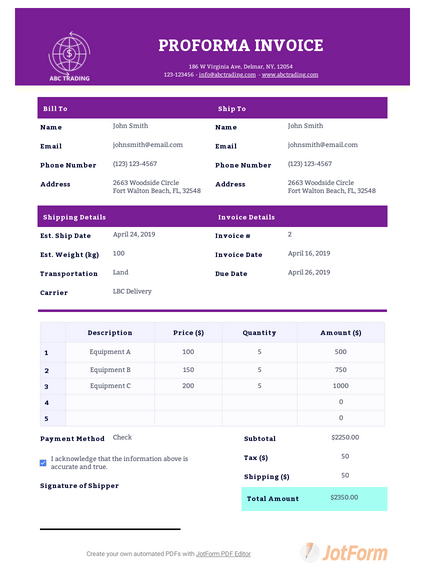
Importance of pro forma invoice
1. A pro forma invoice can be sent along with the goods. If the customer decides to buy the goods, the exact amount stated on the pro forma invoice is paid.
2. A pro forma invoice is a polite way of asking for payment before goods can be dispatched.
3. For goods imported into Nigeria, a pro forma invoice shows the customs authorities the value of the goods so imported. In this way, custom authorities can determine the appropriate custom duties.
4. A pro forma invoice enables the consignee, or an accredited agent ,to know the price at which the owner of some goods wishes to sell the goods.
NOTE: It needs to be emphasized the when an invoice is prepared, a sale has taken place. This is clearly not the position with pro forma invoice .A pro forma invoice may not lead to sale of goods.
Receipt
The seller acknowledges payment by issuing a receipt to the buyer. The seller issues a receipt when the buyer pays for the goods bought and it has to be stated whether it is by cash or cheque.

Contents of a receipt include:
The name and addresses of the seller
Names and addresses of the buyer
Serial number of the receipt
Amount received in words and in figures
Method of payment e.g cash or cheque
Signature of the cashier or receiver of the amount paid
Date of payment
Evaluation:
1. Define office procedure
2. Outline four importance of office procedure
LESSON 5
METHODS OF MAKING PAYMENT THROUGH COMMERCIAL BANKS
Methods of Making Payment Through Commercial Banks
a) Cash Payment
b) Cheque
c) Bank draft
d) Bank transfer
e) Cashless system
Cash Payment:
In Nigeria, this is the most prominent means of payment for business transactions .It is done by paying raw money which is legal tender.
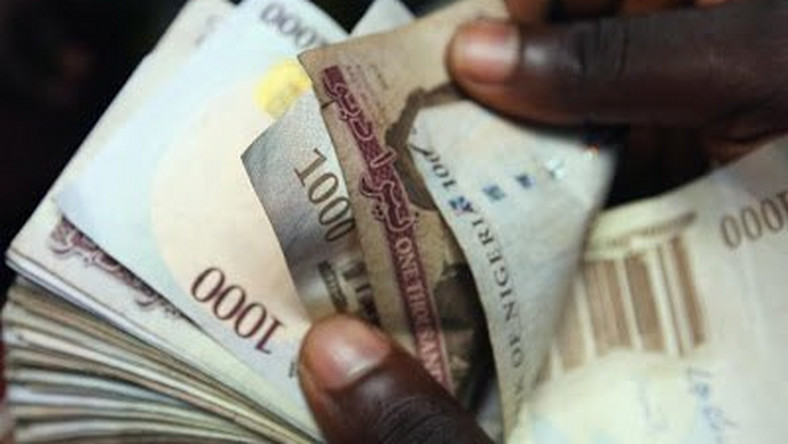
Cheque:
A cheque is written order to a bank to pay a certain sum of money to another person. The use of cheques is the widest method of payment through commercial banks. The amount to be paid is entered twice by the owner of the cheque.The first entry is made in words and the second entry is made in figures.
Types of cheque
I. Bearer Cheque
II. Order Cheque
III. Open cheque
IV. Crossed cheque
Bearer Cheque
A bearer cheque contains the instruction `pay to…or bearer`.So the bearer cheque will be paid to anybody who presents it for payment. A major disadvantage of the bearer cheque is that if it is stolen, the thief will find it easy the cheque. That is ,his or her name and signature must be written behind the cheque and the name must correspond with the name written on the front of the cheque.

Order Cheque
An order cheque contains the instruction` pay to …or Order`.Unlike a bearer cheque, an order cheque must be endorsed by the payee before payment is made to him.

Open Cheque
An open cheque is one that can be cashed across the counter by the payee.A major disadvantages of the open cheque is that a wrong person can cash it.
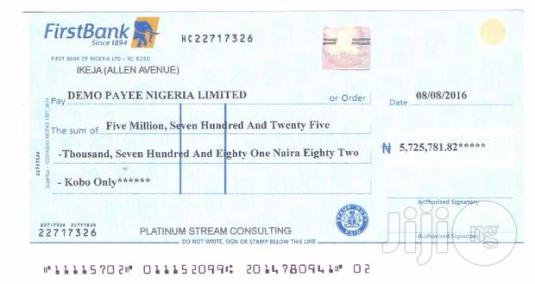
Crossed Cheque
If a cheque is crossed, then such a cheque can only be paid into a current
account. It has two parallel lines drawn across its face.
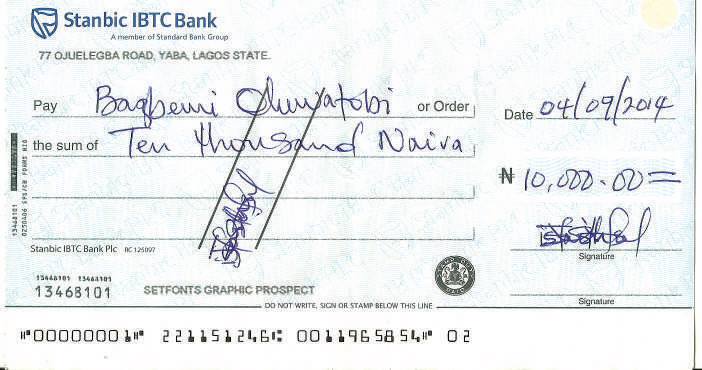
Parties to a cheque
Three parties are involved in the payment of a cheque:
a. The Drawer: this is the person who draws and signs the cheque, and from whose account the money is removed.
b. The Drawee: this is the bank on whom the cheque has been drawn.
c. The payee: this is the person to whom the amount of money on the cheque is paid.
Advantages of cheque system
1. Cheques provide a simple method of cash transfer.
2. Cheques provide a relatively safe method for the settlement of debts.
3. Cheques provide a simplified method for the payment of salaries and wages.
4. Cheques eliminate the burden and danger of carrying large amounts
From place to place.
5. Cheques minimize fraud in business transactions.
Bank draft
A bank draft is written order for money to be paid by a bank, especially from one bank to another. It is a cheque drawn by a bank on itself. Normally, a bank draft is prepared by a commercial bank. A commercial bank drawing a bank draft should have received an equivalent amount, plus a standard commission from the person buying the draft.

Bank transfer
Bank transfer is the most common method of payment worldwide with millions of transactions processed daily. It is a method where by the buyer instructs his or her bank to transfer some money from his or her account to the account of the seller whether in the same bank or in another bank.In these days of on-line banking, it is very easy to pay some money into an account from any branch of the same bank in Nigeria.For international transfers, there are money transfer services offered by banks e.g Money Gram, Western Union, etc.
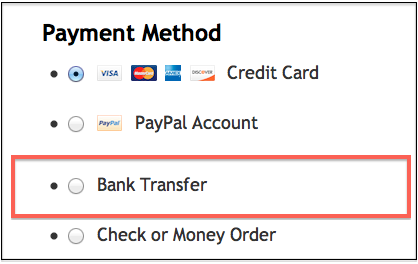
Cashless system
This is an electronic means of making payment. This policy was introduced in Nigeria by
the Central Bank Of Nigeria(CBN) wih its pilot implementation to take place in six states of the federation. It has been averred by experts that cashless policy will enhance the value creation process of the economy.
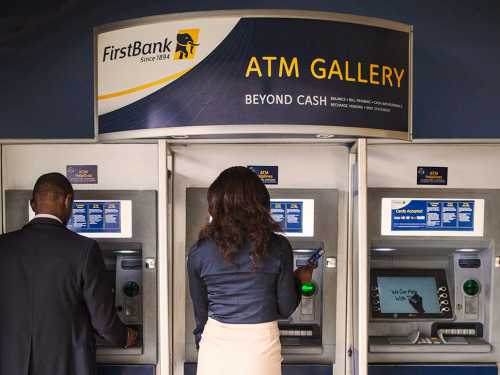
Objectives:
To reduce cost minting and handling cash
To enhance electronic payment system
To reduce associated risks with cash handling
To reduce corruption
Challenges:
Difficulty in procuring POS machines and e-payment platforms
Internet/network link failures
Power and equipment failures
Possible fraud avenues
Customers` apathy for use of electronic payments
Evaluation:
1.List three procedures for making payments
2. Define cheque
3. Highlight four advantages of using cheque over cash system.
4. What do you understand by the term` Cash-lite/Cashless policy` in Nigeria?
ASSIGNMENT:
1.office procedure is important for…………………. a).increasing of size (b)keeping missing documents (c)making office work efficient and effective (d)introducing people in the department
2. The seller acknowledges payment by issuing a …………of goods and services
(a) Cheque (b) receipt (c) delivery book (d) cash book
3.A……………. is not a party to a cheque (a)drawer (b)drawee (c)payee (d)debtor
4. The invoice provides the following information except…………… (a) date of transaction (b) quantity of goods (c)foreign currency (d) terms of trade
5.A cheque is said to be crossed when it is………………..(a)properly signed (b)withdrawn from the bank (c) with two parallel lines drawn across its face
(d) rejected
Topic: OFFICE PROCEDURE
CONTENT: (i) Meaning and importance of office procedure
(ii) Procedures for preparing bills, invoice and receipts
(iii) Computer software, Typewriter, Adding machines
(iv) Procedures for making payments by: cash, bank transfer, cheque,
and bank draft.
MEANING AND IMPORTANCE OF OFFICE PROCEDURE
MEANING OF OFFICE PROCEDURE:
It is a set of rules or policies guiding the operations of an office. Office procedures set the standard for how staff works together in the office.

IMPORTANCE OF OFFICE PROCEDURE:
1. It ensures efficient running of an office.
2. Office procedures create a uniform way of doing things, that is,
Consistency, efficiency and professionalism within the office environment.
3. Office procedure instills disciple in an organisation (e.g no personal phone
calls, checking voice mail in the mornings, no unnecessary conversations with
Clients etc).
4. It helps us to know how to handle both incoming and outgoing mails.
5. It makes for an organized office environment
6. It helps office workers to understand their various assigned duties.
PROCEDURE FOR PREPARING SOME OF THE DOCUMENTS USED IN THE OFFICE
Service Bill: Companies which provide specialized services use service bills as demands for payment.
In Nigeria, PHCN and Nigerian Water Corporation two organizations well-known for using service bills as demands for payments.Usually, service bills are sent to customers on a monthly basis, and the bills show current charges, where payment is to be made as well as rental charges, if any.
Invoice:
This is a document sent by the seller to a buyer showing the description, quantity, price of goods bought.In everyday business transactions, when a buyer buys goods from a seller, the seller issues an invoice which outlines the following details:
i) Order number and date
ii) Quantity and description of goods bought
iii) Unit price
iv) Total price
v) Net amount payable
vi) Terms of delivery
The main purpose of an invoice is to outline the customer`s extent of indebtedness to the supplier.

Purpose of an invoice:
1. When used as a proforma invoice, an invoice is sent as a receipt for an order.
2. An invoice can be used to inform the warehouse about the types of goods to be withdrawn from the stock.
3. An invoice can be used to inform the wholesaler about goods to be produced or supplied.
4. An invoice can be used as an advice note to the transport department
5. An invoice can serve as a delivery note, when used to identify the goods dispatched.
6. An invoice enables the accounts department to know the amount to collect from the customer.
Pro forma invoice
This is a type of invoice sent in advance of goods, to show that the goods are being dispatched and what amount will feature on the invoice proper. A pro forma invoice is prepared by the seller and sent to the buyer.

Importance of pro forma invoice
1. A pro forma invoice can be sent along with the goods. If the customer decides to buy the goods, the exact amount stated on the pro forma invoice is paid.
2. A pro forma invoice is a polite way of asking for payment before goods can be dispatched.
3. For goods imported into Nigeria, a pro forma invoice shows the customs authorities the value of the goods so imported. In this way, custom authorities can determine the appropriate custom duties.
4. A pro forma invoice enables the consignee, or an accredited agent ,to know the price at which the owner of some goods wishes to sell the goods.
NOTE: It needs to be emphasized the when an invoice is prepared, a sale has taken place. This is clearly not the position with pro forma invoice .A pro forma invoice may not lead to sale of goods.
Receipt
The seller acknowledges payment by issuing a receipt to the buyer. The seller issues a receipt when the buyer pays for the goods bought and it has to be stated whether it is by cash or cheque.

Contents of a receipt include:
The name and addresses of the seller
Names and addresses of the buyer
Serial number of the receipt
Amount received in words and in figures
Method of payment e.g cash or cheque
Signature of the cashier or receiver of the amount paid
Date of payment
Evaluation:
1. Define office procedure
2. Outline four importance of office procedure
LESSON 5
METHODS OF MAKING PAYMENT THROUGH COMMERCIAL BANKS
Methods of Making Payment Through Commercial Banks
a) Cash Payment
b) Cheque
c) Bank draft
d) Bank transfer
e) Cashless system
Cash Payment:
In Nigeria, this is the most prominent means of payment for business transactions .It is done by paying raw money which is legal tender.

Cheque:
A cheque is written order to a bank to pay a certain sum of money to another person. The use of cheques is the widest method of payment through commercial banks. The amount to be paid is entered twice by the owner of the cheque.The first entry is made in words and the second entry is made in figures.
Types of cheque
I. Bearer Cheque
II. Order Cheque
III. Open cheque
IV. Crossed cheque
Bearer Cheque
A bearer cheque contains the instruction `pay to…or bearer`.So the bearer cheque will be paid to anybody who presents it for payment. A major disadvantage of the bearer cheque is that if it is stolen, the thief will find it easy the cheque. That is ,his or her name and signature must be written behind the cheque and the name must correspond with the name written on the front of the cheque.

Order Cheque
An order cheque contains the instruction` pay to …or Order`.Unlike a bearer cheque, an order cheque must be endorsed by the payee before payment is made to him.

Open Cheque
An open cheque is one that can be cashed across the counter by the payee.A major disadvantages of the open cheque is that a wrong person can cash it.

Crossed Cheque
If a cheque is crossed, then such a cheque can only be paid into a current
account. It has two parallel lines drawn across its face.

Parties to a cheque
Three parties are involved in the payment of a cheque:
a. The Drawer: this is the person who draws and signs the cheque, and from whose account the money is removed.
b. The Drawee: this is the bank on whom the cheque has been drawn.
c. The payee: this is the person to whom the amount of money on the cheque is paid.
Advantages of cheque system
1. Cheques provide a simple method of cash transfer.
2. Cheques provide a relatively safe method for the settlement of debts.
3. Cheques provide a simplified method for the payment of salaries and wages.
4. Cheques eliminate the burden and danger of carrying large amounts
From place to place.
5. Cheques minimize fraud in business transactions.
Bank draft
A bank draft is written order for money to be paid by a bank, especially from one bank to another. It is a cheque drawn by a bank on itself. Normally, a bank draft is prepared by a commercial bank. A commercial bank drawing a bank draft should have received an equivalent amount, plus a standard commission from the person buying the draft.

Bank transfer
Bank transfer is the most common method of payment worldwide with millions of transactions processed daily. It is a method where by the buyer instructs his or her bank to transfer some money from his or her account to the account of the seller whether in the same bank or in another bank.In these days of on-line banking, it is very easy to pay some money into an account from any branch of the same bank in Nigeria.For international transfers, there are money transfer services offered by banks e.g Money Gram, Western Union, etc.

Cashless system
This is an electronic means of making payment. This policy was introduced in Nigeria by
the Central Bank Of Nigeria(CBN) wih its pilot implementation to take place in six states of the federation. It has been averred by experts that cashless policy will enhance the value creation process of the economy.

Objectives:
To reduce cost minting and handling cash
To enhance electronic payment system
To reduce associated risks with cash handling
To reduce corruption
Challenges:
Difficulty in procuring POS machines and e-payment platforms
Internet/network link failures
Power and equipment failures
Possible fraud avenues
Customers` apathy for use of electronic payments
Evaluation:
1.List three procedures for making payments
2. Define cheque
3. Highlight four advantages of using cheque over cash system.
4. What do you understand by the term` Cash-lite/Cashless policy` in Nigeria?
ASSIGNMENT:
1.office procedure is important for…………………. a).increasing of size (b)keeping missing documents (c)making office work efficient and effective (d)introducing people in the department
2. The seller acknowledges payment by issuing a …………of goods and services
(a) Cheque (b) receipt (c) delivery book (d) cash book
3.A……………. is not a party to a cheque (a)drawer (b)drawee (c)payee (d)debtor
4. The invoice provides the following information except…………… (a) date of transaction (b) quantity of goods (c)foreign currency (d) terms of trade
5.A cheque is said to be crossed when it is………………..(a)properly signed (b)withdrawn from the bank (c) with two parallel lines drawn across its face
(d) rejected
WEEK 3
LESSON 6
Topic: OFFICE PROCEDURE:
CONTENT::
i.Imprest account: balance and restoration
ii.The role of wages and salaries unit
iii.Store records: meaning and procedure for procurement
iv.Delivery note and gate pass
IMPREST ACCOUNT AND THE ROLE OF WAGES AND SALARIES UNIT
IMPREST ACCOUNT: Large business transactions are settled by cheque and not by cash.However; there are minor expenses which have to be settled by cash. Such items as postage, transport fare, stationery, carriage and cleaning are all paid for in cash. Therefore, enough money will have to be kept handy in the office to meet these expenses. Money kept in the office to meet minor expenses is called petty cash.
Records for these minor expenses are kept in a separate book known as the petty Cash book.A petty cashier is responsible for the petty cash book.
Under the imprest account system,an agreed sum of money is allocated to the petty cashier .At the end of a scheduled period ,the amount spent is refunded to the petty cashier in order to restore the account to the original amount.The original amount agreed upon is called an imprest or float.This method of keeping the petty cash is known as the imprest system.
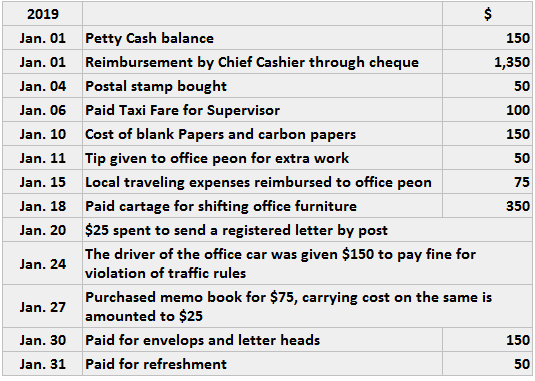
WAGES OFFICE:
A wage office is that office in an organization which handles the payment of wages.
Wages: wages constitute the reward for labour.Wages refers to payments made to unskilled labour.In other words, wage is defined as the hourly, daily or weekly compensation paid to workers for their labour.
Salary: This is the total financial remuneration paid to full time employees in exchange for their labour.
Differences between wages and salaries
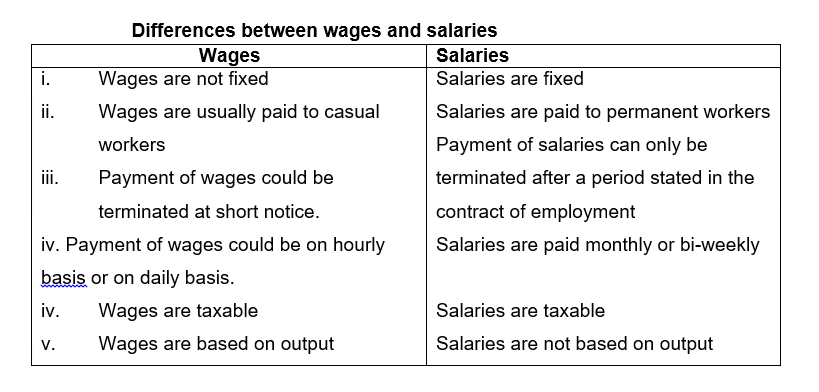
The role of wages and salaries unit:
1. The wages office calculates and pays the correct amount of wages due
to each worker
2. The wages office records the difference between gross pay and net pay.
3. The wages office records and makes the necessary deductions from the pay
of each worker.
4. The wages office calculates the number of hours put in by each worker
and hence the total amount due to such a worker.
5. The wages office compiles the total amount of wages paid to all the workers and hence the cost of labour of the organization.
Pay roll:
The pay roll shows the list of workers employed by the organization and the amount of wages each person is to be paid. The following information can be found in the pay roll:
Employees number
Employees name
Salary grade level
Basic pay
Allowances
Gross pay
Statutory deduction
Net pay
Signature
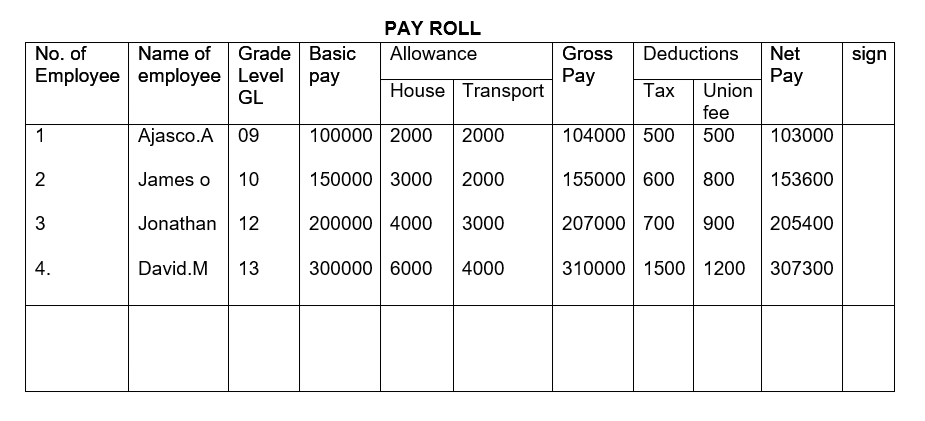
Pay slip/Pay Advice: This is a small statement issued by the wages office to the staff or workers of an organization .It is given to every employee of an organization at the end of each month to show how their net pay is calculated. It is enclosed in the pay envelope of the except for the who receive their salary through the bank who have to collect their pay slip from the wages office to be able to know how much was paid to them that month.

Evaluation:
1. In a tabular form, give four differences between wages and salaries
2. Mention five roles of salaries and wages unit in any organization
3. Differentiate between payroll and pay slip
LESSON 7
MEANING AND IMPORTANCE OF STORE RECORDS
Meaning of store
A store is a place where goods are kept for future use. The goods here may be raw materials, semi-finished goods or finished goods
STORE RECORDS
Store records are documents that help an organization to determine the quantity of goods available in the store. They also help the organization to know the materials that have been issued out or used and those that have not been used.The stock department is responsible for safe keeping of the stock of either raw materials or finished goods.
Documents used in the stock department
A number of documents used in the stock department include:
1. Stock requisition form
2. Stock card
3. Purchase requisition form
4. Delivery Note
5. Gate pass
Stock requisition form
The form is used when collecting goods from the store. Any department within the organization, which requires any goods from the store will normally complete the stock requisition form.

Stock card
A stock card is prepared for each item of material. The stock card shows how the material is being issued out from the store and the quantity being put into stock. The stock card also shows the date on which an item was issued out ,the requisition form number, the department which made the request and the balance in stock.
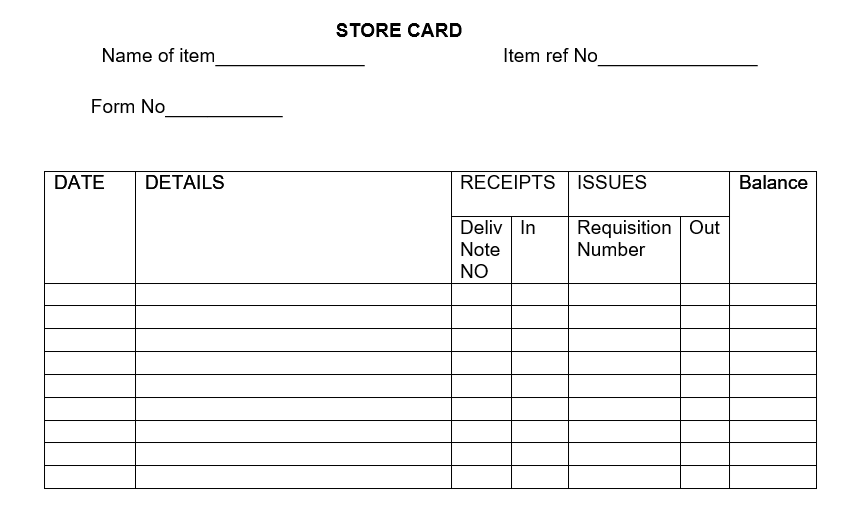
Purchase requisition form
Quite often, stock falls to a re-order level that is, a low level, at which stock must be replenished. At this level, the storekeeper informs the Purchasing Department of the need to replenish stock. This is done by completing a form called the purchase requisition.

Delivery Note
A delivery note is normally sent alongside the goods. It states the types and quantity of goods delivered. It does not state the prices of the goods being delivered .The delivery note is used to check if the goods delivered are as ordered.
Gate Pass
The gate pass is used to control the movement of goods and people in and out of organization. It is basically used by the security department of an organization to ascertain the authorization of individuals to move out company`s goods and properties.
Importance of store records
The importance of store records is outlined as follows:
1. Store records help to minimize fraud
2. Store records are used to ascertain the balance of such balance.
3. Store records accurately indicate the time for the purchase of more items
4. Store records show the re-order level, the minimum stock and the maximum stock.
5. Stock records help in reconciling the recorded balance of stock with stock that is physically available in the store.
Store Procurement
Store procurement is the responsibility of the Purchasing Department.The storekeeper and the purchasing officer both play an important role in the procurement of materials needed by the organization.
Procedure for store procurement
1. A purchase requisition form is completed, giving details of materials to be procured.
2. Two copies of the requisition form are prepared; the top copy is forwarded to
the purchasing officer while the duplicate goes to the production manager.
3. The purchasing officer selects a suitable supplier who quoted the most
Competitive price.
4. A purchase order is issued to the supplier. This is a legal contract between the
Supplier and the company.
5. The goods are delivered and inspected.
6. A receipt is given to the carrier
7. A Goods Received Note and an Inspection Note are raised and signed by
the appropriate officer, especially the storekeeper.
Meaning of Stock-taking
Stock-taking refers to the physical count of goods in the storeroom or warehouse so as to reconcile the physical stock balance and the book balance.
Importance of stock-taking:
Stock-taking is important in business for the following reasons:
i) It helps to control the level of stock held
ii) Stock-taking helps to ensure that stock is replenished as and when due.
iii) Store taking shows the efficiency or otherwise of store management.
iv) It alerts the company when there is loss of stock through theft, misuse or damage.
v) Stock taking provides accurate stock valuations that are needed for the preparation of the annual account.
Evaluation:
1. Define store records
2. Mention four documents used by the stock department
3. Outline five importance of keeping proper records by the store department
4. The following are the details of pay of the employees of Diva Company for the month of August, 2012.
Mr. Paul
Basic salary £100,000
House allowance £40,000
Transport allowance 30,000
He pays 10% of his basic salary as tax
Union dues 5% on basic salary
Car loan £1,000
Furniture loan £500
Mr. Giwa
Basic salary£120,000
House allowance£ 45000
Transport allowance£35,000
10% of his basic salary as tax
Union due 5% on basic salary
Car loan £2,000
Furniture loan£1,000
Mrs .Jerome
Basic salary £150,000
House allowance£50,000
Transport allowance £40,000
10% of basic pay as tax
Union due is 5% on basic pay
You are required to compute :(a) amount each staff would pay as tax (b) how much each would pay as union due (c) prepare a pay roll that shows gross pay ,deductions and the net pay of each employee.
ASSIGNMENT
1.The following are examples of stores except (a)Raw materials (b) motor vehicles(c)tools (d)finished goods
2.The financial remuneration paid to full-time employees at the end of the month is called (a) pay roll (b) pay slip (c) salary (d)wages
3……….. is defined as hourly financial remuneration paid to operating employees in exchange for their labour (a)voucher (b)pay roll (c)salary (d)wage
4.Advice note given to a staff containing the breakdown of their gross pay ,deductions and net pay is called ……………….. (a) employment letter (b) tax resale (c) tax clearance (d) pay slip
5.Which of the following comes first in the pay slip given to staff? (a)deduction (b)Gross pay (c)Net pay (d) Economic recovery tax
6.A sheet which shows the names of all workers and their take home pay is called a …………… (a)pay slip (b)pay advice (c) pay roll (d) voucher
7.Which of the following is a voluntary deduction from workers `salaries (a)income tax (b)rent for those living in government quarters (c) trade union dues (d)economic recovery tax
8.If stock records are to be fully effective, they must be:(a)kept up to date (b)posted once a week (c)posted weekly (d)signed monthly
Topic: OFFICE PROCEDURE:
CONTENT::
i.Imprest account: balance and restoration
ii.The role of wages and salaries unit
iii.Store records: meaning and procedure for procurement
iv.Delivery note and gate pass
IMPREST ACCOUNT AND THE ROLE OF WAGES AND SALARIES UNIT
IMPREST ACCOUNT: Large business transactions are settled by cheque and not by cash.However; there are minor expenses which have to be settled by cash. Such items as postage, transport fare, stationery, carriage and cleaning are all paid for in cash. Therefore, enough money will have to be kept handy in the office to meet these expenses. Money kept in the office to meet minor expenses is called petty cash.
Records for these minor expenses are kept in a separate book known as the petty Cash book.A petty cashier is responsible for the petty cash book.
Under the imprest account system,an agreed sum of money is allocated to the petty cashier .At the end of a scheduled period ,the amount spent is refunded to the petty cashier in order to restore the account to the original amount.The original amount agreed upon is called an imprest or float.This method of keeping the petty cash is known as the imprest system.

WAGES OFFICE:
A wage office is that office in an organization which handles the payment of wages.
Wages: wages constitute the reward for labour.Wages refers to payments made to unskilled labour.In other words, wage is defined as the hourly, daily or weekly compensation paid to workers for their labour.
Salary: This is the total financial remuneration paid to full time employees in exchange for their labour.
Differences between wages and salaries

The role of wages and salaries unit:
1. The wages office calculates and pays the correct amount of wages due
to each worker
2. The wages office records the difference between gross pay and net pay.
3. The wages office records and makes the necessary deductions from the pay
of each worker.
4. The wages office calculates the number of hours put in by each worker
and hence the total amount due to such a worker.
5. The wages office compiles the total amount of wages paid to all the workers and hence the cost of labour of the organization.
Pay roll:
The pay roll shows the list of workers employed by the organization and the amount of wages each person is to be paid. The following information can be found in the pay roll:
Employees number
Employees name
Salary grade level
Basic pay
Allowances
Gross pay
Statutory deduction
Net pay
Signature

Pay slip/Pay Advice: This is a small statement issued by the wages office to the staff or workers of an organization .It is given to every employee of an organization at the end of each month to show how their net pay is calculated. It is enclosed in the pay envelope of the except for the who receive their salary through the bank who have to collect their pay slip from the wages office to be able to know how much was paid to them that month.

Evaluation:
1. In a tabular form, give four differences between wages and salaries
2. Mention five roles of salaries and wages unit in any organization
3. Differentiate between payroll and pay slip
LESSON 7
MEANING AND IMPORTANCE OF STORE RECORDS
Meaning of store
A store is a place where goods are kept for future use. The goods here may be raw materials, semi-finished goods or finished goods
STORE RECORDS
Store records are documents that help an organization to determine the quantity of goods available in the store. They also help the organization to know the materials that have been issued out or used and those that have not been used.The stock department is responsible for safe keeping of the stock of either raw materials or finished goods.
Documents used in the stock department
A number of documents used in the stock department include:
1. Stock requisition form
2. Stock card
3. Purchase requisition form
4. Delivery Note
5. Gate pass
Stock requisition form
The form is used when collecting goods from the store. Any department within the organization, which requires any goods from the store will normally complete the stock requisition form.

Stock card
A stock card is prepared for each item of material. The stock card shows how the material is being issued out from the store and the quantity being put into stock. The stock card also shows the date on which an item was issued out ,the requisition form number, the department which made the request and the balance in stock.

Purchase requisition form
Quite often, stock falls to a re-order level that is, a low level, at which stock must be replenished. At this level, the storekeeper informs the Purchasing Department of the need to replenish stock. This is done by completing a form called the purchase requisition.

Delivery Note
A delivery note is normally sent alongside the goods. It states the types and quantity of goods delivered. It does not state the prices of the goods being delivered .The delivery note is used to check if the goods delivered are as ordered.
Gate Pass
The gate pass is used to control the movement of goods and people in and out of organization. It is basically used by the security department of an organization to ascertain the authorization of individuals to move out company`s goods and properties.
Importance of store records
The importance of store records is outlined as follows:
1. Store records help to minimize fraud
2. Store records are used to ascertain the balance of such balance.
3. Store records accurately indicate the time for the purchase of more items
4. Store records show the re-order level, the minimum stock and the maximum stock.
5. Stock records help in reconciling the recorded balance of stock with stock that is physically available in the store.
Store Procurement
Store procurement is the responsibility of the Purchasing Department.The storekeeper and the purchasing officer both play an important role in the procurement of materials needed by the organization.
Procedure for store procurement
1. A purchase requisition form is completed, giving details of materials to be procured.
2. Two copies of the requisition form are prepared; the top copy is forwarded to
the purchasing officer while the duplicate goes to the production manager.
3. The purchasing officer selects a suitable supplier who quoted the most
Competitive price.
4. A purchase order is issued to the supplier. This is a legal contract between the
Supplier and the company.
5. The goods are delivered and inspected.
6. A receipt is given to the carrier
7. A Goods Received Note and an Inspection Note are raised and signed by
the appropriate officer, especially the storekeeper.
Meaning of Stock-taking
Stock-taking refers to the physical count of goods in the storeroom or warehouse so as to reconcile the physical stock balance and the book balance.
Importance of stock-taking:
Stock-taking is important in business for the following reasons:
i) It helps to control the level of stock held
ii) Stock-taking helps to ensure that stock is replenished as and when due.
iii) Store taking shows the efficiency or otherwise of store management.
iv) It alerts the company when there is loss of stock through theft, misuse or damage.
v) Stock taking provides accurate stock valuations that are needed for the preparation of the annual account.
Evaluation:
1. Define store records
2. Mention four documents used by the stock department
3. Outline five importance of keeping proper records by the store department
4. The following are the details of pay of the employees of Diva Company for the month of August, 2012.
Mr. Paul
Basic salary £100,000
House allowance £40,000
Transport allowance 30,000
He pays 10% of his basic salary as tax
Union dues 5% on basic salary
Car loan £1,000
Furniture loan £500
Mr. Giwa
Basic salary£120,000
House allowance£ 45000
Transport allowance£35,000
10% of his basic salary as tax
Union due 5% on basic salary
Car loan £2,000
Furniture loan£1,000
Mrs .Jerome
Basic salary £150,000
House allowance£50,000
Transport allowance £40,000
10% of basic pay as tax
Union due is 5% on basic pay
You are required to compute :(a) amount each staff would pay as tax (b) how much each would pay as union due (c) prepare a pay roll that shows gross pay ,deductions and the net pay of each employee.
ASSIGNMENT
1.The following are examples of stores except (a)Raw materials (b) motor vehicles(c)tools (d)finished goods
2.The financial remuneration paid to full-time employees at the end of the month is called (a) pay roll (b) pay slip (c) salary (d)wages
3……….. is defined as hourly financial remuneration paid to operating employees in exchange for their labour (a)voucher (b)pay roll (c)salary (d)wage
4.Advice note given to a staff containing the breakdown of their gross pay ,deductions and net pay is called ……………….. (a) employment letter (b) tax resale (c) tax clearance (d) pay slip
5.Which of the following comes first in the pay slip given to staff? (a)deduction (b)Gross pay (c)Net pay (d) Economic recovery tax
6.A sheet which shows the names of all workers and their take home pay is called a …………… (a)pay slip (b)pay advice (c) pay roll (d) voucher
7.Which of the following is a voluntary deduction from workers `salaries (a)income tax (b)rent for those living in government quarters (c) trade union dues (d)economic recovery tax
8.If stock records are to be fully effective, they must be:(a)kept up to date (b)posted once a week (c)posted weekly (d)signed monthly
WEEK 4
LESSON 8
Topic: OFFICE EQUIPMENT:
CONTENT: (i) Meaning of office equipment
(ii) Identification of office equipment
(iii) Types of office equipment
(iv) Importance and use of office equipment
(V) care of office equipment
MEANING AND TYPES OF OFFICE EQUIPMENT
MEANING OF OFFICE EQUIPMENT
Office equipment are machines, tools or devices that facilitate or simplify the activities in an office.
TYPES OF OFFICE EQUIPMENT
The following are some of equipment used in office:
i. Computers
ii. Photocopier
iii. Typewriter
iv. Calculator
V. Laminating machine
vi. Paper clips
vii. Perforator
viii. Stapler
ix. Sharpener
x. Shredder
xi. Cassette player
xii. File Cabinet
xiii.Printer
xiv. Scanning machine
xv. Binding machine
xvi. Guillotine machine
xvii. Air-Conditioner
xviii. Fans(standing/ceiling)
xix. Call bell
xx. Handsets
TYPEWRITER
This is a simple basic office machine and it is very common in various offices. It is used to produce business letters and documents so that they are presented in a better style and are more readable than they would be if hand-written.
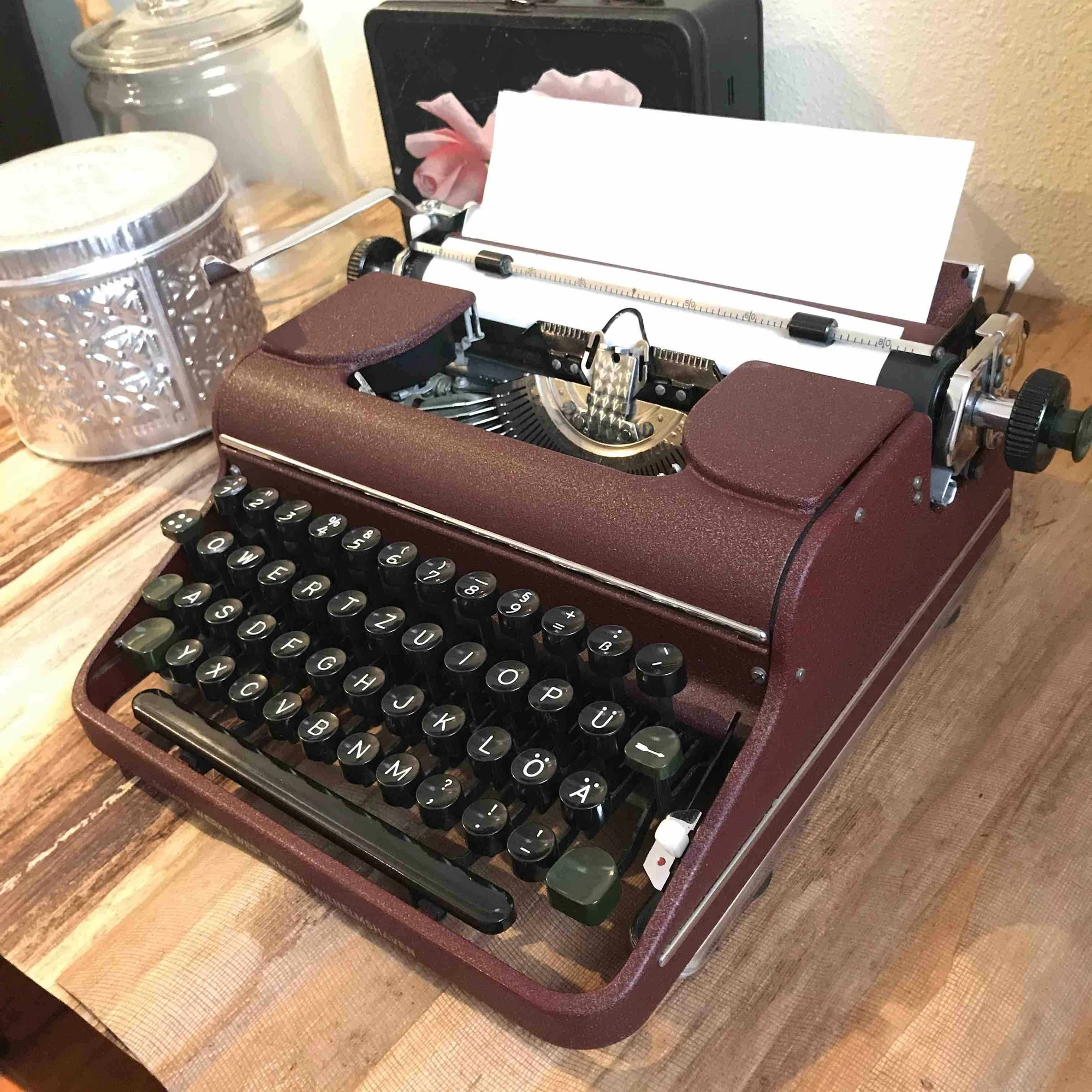
STAPLER
This is a small metallic device invented by man in order to assist him in reducing the degree of manual labour.It is commonly used in various offices to fasten or put documents together .Staplers cannot operate by itself rather it requires human effort .It is a simple machine that makes use of staple pins and they are of different sizes.
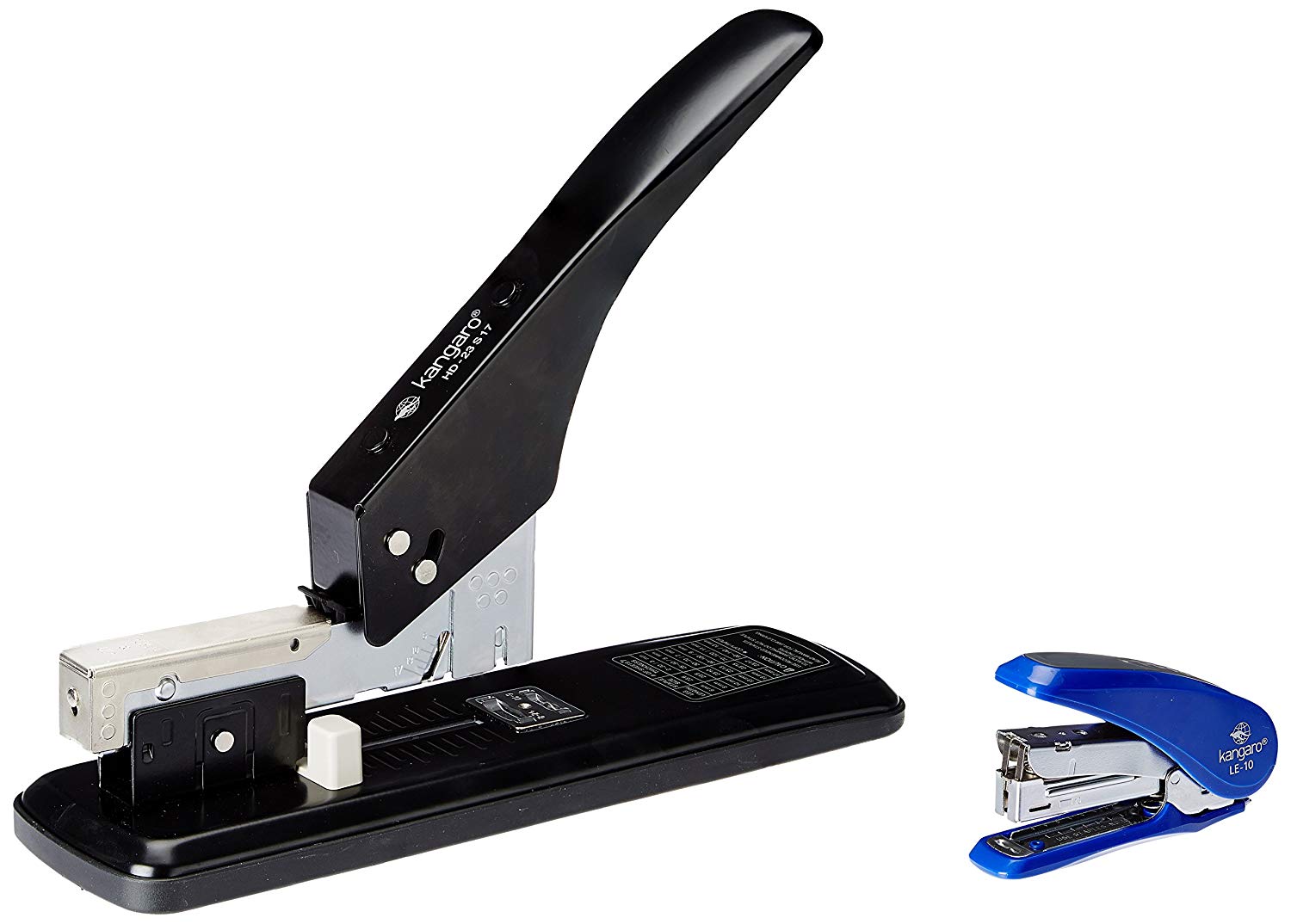
CALCULATOR
This is another machine that is commonly used in offices especially in business transactions that involves counting ,buying and selling and making payments.A simple calculator can be used to perform the functions of addition,subtraction,multiplication and division.

COMPUTER
This is an electronic data processing device or machine with high credit for speed and accuracy .Information is processed and stored for later usage.This machine is now common in modern offices and it is capable of engaging in office jobs having to do with figures and texts.
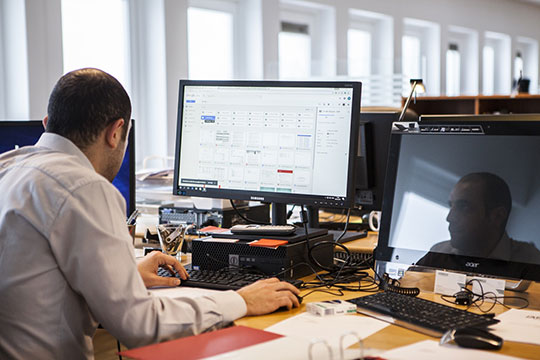
PRINTERS
Printers are electronic devices that are used to reveal on paper the work done on a computer.That is, it brings out finished work of a computer that can be read on paper.

THE PHOTOCOPIER
This is an electronic machine used to reproduce exact copies of a document.

THE FILING CABINET
This is a strong device which consists of drawers in which files and other important documents and valuables are kept.A filing cabinet can be made of wood or iron and can be locked if necessary.
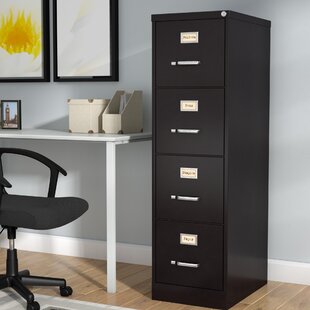
ADDING AND CALCULATING MACHINE
The is used form adding,subtracting,multiplying and diving numbers.It makes calculations faster ,easier and accurate.

PERFORATOR
A perforator is small piece of office equipment used to make holes neatly in papers before they are put into a file.
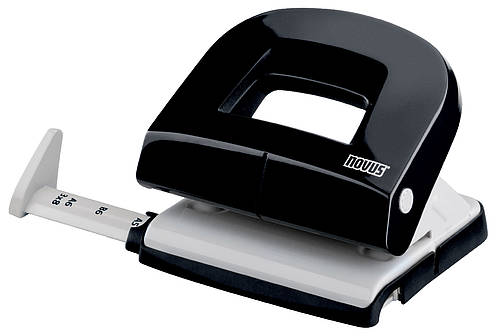
DUPLICATING MACHINE
A duplicating machine is a device that can reproduce copy or print work. It uses a special sheet called stencils on the surface of which characters may be typed and/or pictures drawn.
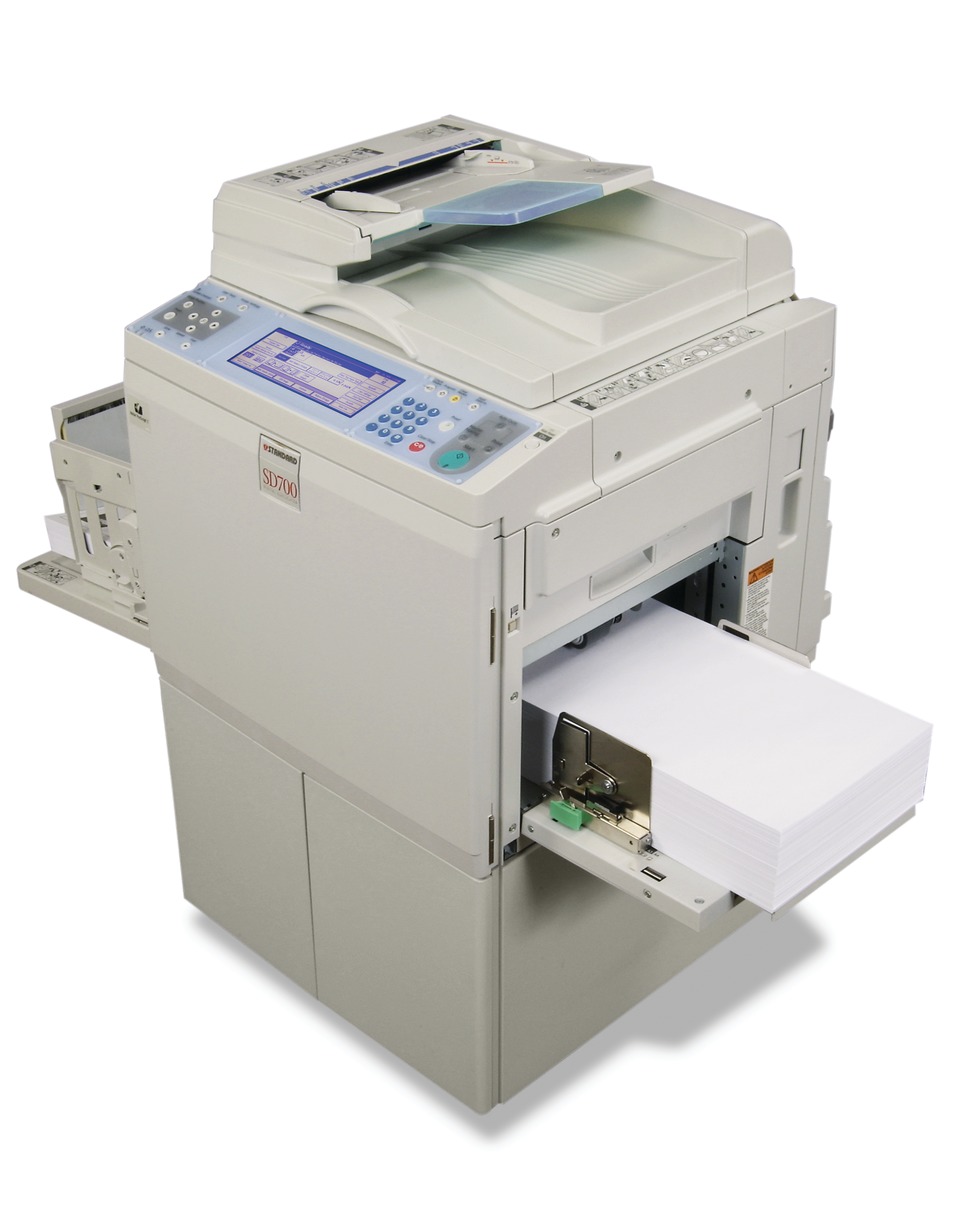
Evaluation:
1. Define office equipment
2. List five types of office equipment
LESSON 9
IMPORTANCE AND CARE OF OFFICE EQUIPMENT:
1. Workers are relieved of too much arduous work
2. Office equipment saves time
3. Accuracy is ensured
4. hand-written work is reduced
5. It reduces fatigue
6. Use of appropriate machine can help in the prevention of fraud
CARE OF OFFICE EQUIPMENT
Cover after use
Regular servicing
Avoid overuse/work
Always make use of expert/technical know how
Equipment like computer should be air-conditioned
Use of correct stationery
Use of stabilizer to regulate electric voltage
Be vigilant to see warning signals
Turn off the machine appropriately after use
Follow the instruction/direction of operation strictly
Dust ,brush or clean regularly

Evaluation:
1. List five importance of office equipment
2. Mention five ways of caring for office equipment
ASSIGNMENT
1. Which of the following office equipment is not electrically operated? (a) Calculating machine (b) duplicating machine (c) perforator (d) photocoping machine (e) typewriter
2. A perforator is a small piece of office equipment used to (a) hold set of paper together (b) store and protect files (c) make holes in papers (d) tear paper to shreds
3. Which of the following office equipment can produce an exact image of the original document? (a)duplicating machine (b)typewriter (c)computer (d) photocopying machine
4…………..is not an office equipment (a) telephone (b) computer (c) rake (d) filing cabinet
5……………….is the office equipment used for keeping important files and documents (a) filing cabinet (b)photocopier (c)stapler (d)printer
Topic: OFFICE EQUIPMENT:
CONTENT: (i) Meaning of office equipment
(ii) Identification of office equipment
(iii) Types of office equipment
(iv) Importance and use of office equipment
(V) care of office equipment
MEANING AND TYPES OF OFFICE EQUIPMENT
MEANING OF OFFICE EQUIPMENT
Office equipment are machines, tools or devices that facilitate or simplify the activities in an office.
TYPES OF OFFICE EQUIPMENT
The following are some of equipment used in office:
i. Computers
ii. Photocopier
iii. Typewriter
iv. Calculator
V. Laminating machine
vi. Paper clips
vii. Perforator
viii. Stapler
ix. Sharpener
x. Shredder
xi. Cassette player
xii. File Cabinet
xiii.Printer
xiv. Scanning machine
xv. Binding machine
xvi. Guillotine machine
xvii. Air-Conditioner
xviii. Fans(standing/ceiling)
xix. Call bell
xx. Handsets
TYPEWRITER
This is a simple basic office machine and it is very common in various offices. It is used to produce business letters and documents so that they are presented in a better style and are more readable than they would be if hand-written.

STAPLER
This is a small metallic device invented by man in order to assist him in reducing the degree of manual labour.It is commonly used in various offices to fasten or put documents together .Staplers cannot operate by itself rather it requires human effort .It is a simple machine that makes use of staple pins and they are of different sizes.

CALCULATOR
This is another machine that is commonly used in offices especially in business transactions that involves counting ,buying and selling and making payments.A simple calculator can be used to perform the functions of addition,subtraction,multiplication and division.

COMPUTER
This is an electronic data processing device or machine with high credit for speed and accuracy .Information is processed and stored for later usage.This machine is now common in modern offices and it is capable of engaging in office jobs having to do with figures and texts.

PRINTERS
Printers are electronic devices that are used to reveal on paper the work done on a computer.That is, it brings out finished work of a computer that can be read on paper.

THE PHOTOCOPIER
This is an electronic machine used to reproduce exact copies of a document.

THE FILING CABINET
This is a strong device which consists of drawers in which files and other important documents and valuables are kept.A filing cabinet can be made of wood or iron and can be locked if necessary.

ADDING AND CALCULATING MACHINE
The is used form adding,subtracting,multiplying and diving numbers.It makes calculations faster ,easier and accurate.

PERFORATOR
A perforator is small piece of office equipment used to make holes neatly in papers before they are put into a file.

DUPLICATING MACHINE
A duplicating machine is a device that can reproduce copy or print work. It uses a special sheet called stencils on the surface of which characters may be typed and/or pictures drawn.

Evaluation:
1. Define office equipment
2. List five types of office equipment
LESSON 9
IMPORTANCE AND CARE OF OFFICE EQUIPMENT:
1. Workers are relieved of too much arduous work
2. Office equipment saves time
3. Accuracy is ensured
4. hand-written work is reduced
5. It reduces fatigue
6. Use of appropriate machine can help in the prevention of fraud
CARE OF OFFICE EQUIPMENT
Cover after use
Regular servicing
Avoid overuse/work
Always make use of expert/technical know how
Equipment like computer should be air-conditioned
Use of correct stationery
Use of stabilizer to regulate electric voltage
Be vigilant to see warning signals
Turn off the machine appropriately after use
Follow the instruction/direction of operation strictly
Dust ,brush or clean regularly

Evaluation:
1. List five importance of office equipment
2. Mention five ways of caring for office equipment
ASSIGNMENT
1. Which of the following office equipment is not electrically operated? (a) Calculating machine (b) duplicating machine (c) perforator (d) photocoping machine (e) typewriter
2. A perforator is a small piece of office equipment used to (a) hold set of paper together (b) store and protect files (c) make holes in papers (d) tear paper to shreds
3. Which of the following office equipment can produce an exact image of the original document? (a)duplicating machine (b)typewriter (c)computer (d) photocopying machine
4…………..is not an office equipment (a) telephone (b) computer (c) rake (d) filing cabinet
5……………….is the office equipment used for keeping important files and documents (a) filing cabinet (b)photocopier (c)stapler (d)printer
WEEK 5
LESSON 10
TOPIC: ADVERTISING
CONTENT:
i. Meaning of Advertising
ii.Types of Advertising
iii. Functions of Advertising
iv. Forms of Advertising media:-Radio, Television, Newspapers, Magazines, Handbills, Internet, Bill Boards, etc.
v. Advertising Ethics.
ADVERTISING, TYPES AND FUNCTIONS
MEANING OF ADVERTISING:
Advertising means calling the attention of members of the public (audience) to a product, service or an idea in order to encourage them to buy.

FEATURES OF GOOD ADVERTISING:
i.it must arrest attention
ii.it must convince the prospective to buy
iii.it should create a permanent, good impression of the commodity in the mind of the buyers
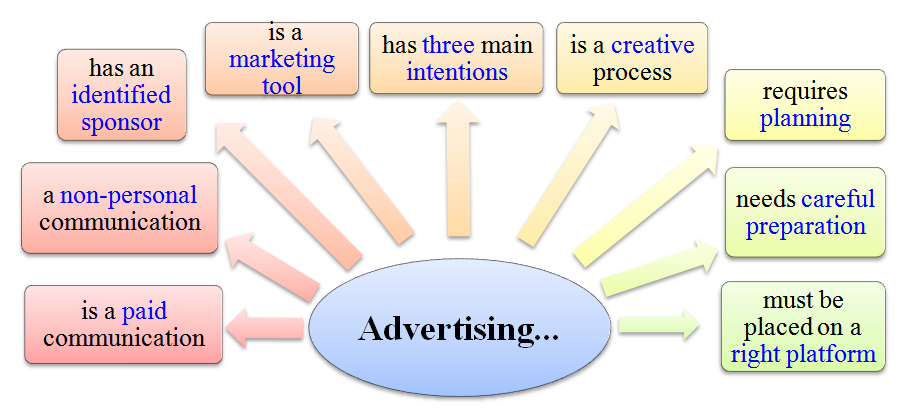
TYPES OF ADVERTISING
1. Informative Advertising: This is designed to make members of the public aware of new facts and about what they have not heart of before. This type of advertising is mostly used to call the attention of the audience to the existence of new goods ,products and services in the market.
2.Persuasive Advertising:This calls on the people to buy and use a product or service irrespective of what their attitude may be towards such a product or service.Various devices and well chosen words are used to make people believe in the advertising appeal.It attempts to convince the audience that one`s product is better than the other.
3.Competitive Advertising: This types of advertising seeks to persuade the consumer to use a particular type of product in preference to another.It is mostly to advertise goods that have many substitutions e.g detergents ,toilet-soaps, beer, tooth-pastes,etc.It can used to break through a monopoly.
4. Mass Advertising: Mass advertising takes place when producers of a particular line of goods decide to advertise for the general use of such goods without mentioning a particular brand.
5. Specific Advertising: This directs the appeal on a particular brand of goods or services.
https://www.slideshare.net/KatieTaplin/ ... g-69088207
FUNCTIONS OF ADVERTISING
I.It helps to inform the public (potential consumers) about the availability of new products, services and the continued existence of older ones.
ii.It increases the market share of the company`s product
iii.It informs and educates the consumers about the use of a product or service
iv.Advertising informs people where to obtain goods and services
v.It ensures frequent use of goods and sustains demand
vi.Advertising improves the quality of goods and services
vii.It provides employment opportunities
viii.It enhances the turnover of the firm
ix.It promotes the image of the firm.
Evaluation:
1. Define advertising
2. List four types of advertising
3. List five functions of advertising
LESSON 11
FORMS OF ADVERTISING MEDIA AND ADVERTISING ETHICS
FORMS OF ADVERTISING MEDIA
An advertising medium is a means through which information about goods and services is conveyed to the public or target audience. Advertising media include the following:
a) Television
b) Radio
c) Newspapers
d) Internet
e) Billboards
f) Magazines
g) Cinemas
TELEVISION
The required information that is intended to establish a good image for the business,is often sent as news items through the television in order to serve a very large audience.

Advantages of using Television
The true form and colour of the product can be seen
The method of using the product can be demonstrated
It helps to reach very many audience especially in the urban centres
Disadvantages
It is expensive
Impulse buying may be misleading
Only television owners can be aware of the product
RADIO
There is little doubt that radio is at the reach of every home in Nigeria. It is thus,
an effective medium of advertisement as it can get to the remotest part of the country.
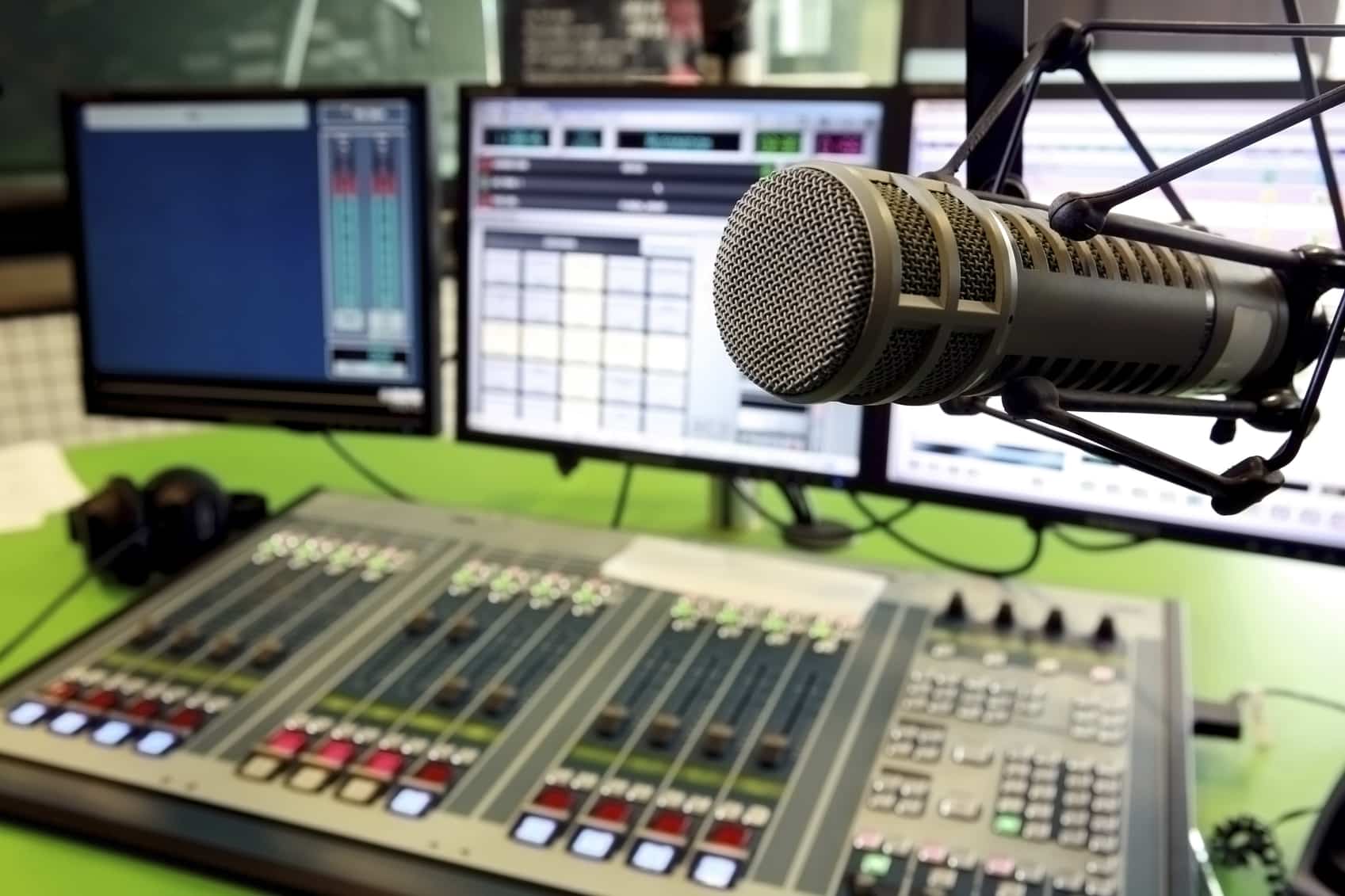
Advantage of using Radio
It has a very wide coverage
It is very cheap to possess
It is durable
It can use alternative power source e.g battery
It is portable
Disadvantages
Advert on radio is usually short
NEWSPAPERS
Newspapers are an important means of advertising one`s goods and services. They are the most used medium of advertisement and are considered cheaper when compared with other means like radio and television.
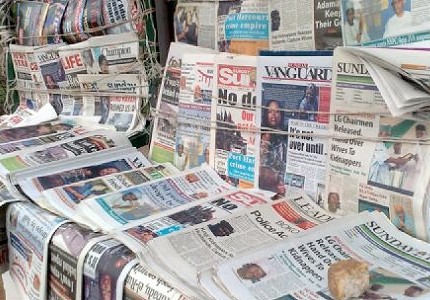
INTERNET
Internet advertisement is the latest form of advertising in Nigeria and in many parts of the world.It is an electronic form of advertising products.
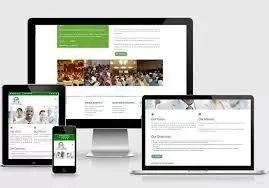

Advantages of internet
It is used to reach a very large population through its global coverage
It creates global market for the products
Disadvantages
It can be accessed only by those who own computers and are connected to the internet
It can only reach those who are computer literate and are used to access the internet
It can easily be used for fraudulent practices
BILLBOARDS
These are very large and tall sign-posts mounted in strategic locations in cities and towns. It is used to advertise goods.Often,a very large picture of the product or person being advertised is clearly shown on it.

MAGAZINES
These could be used within or outside the organization to inform employees and the public about a company`s activities. Magazines are usually weekly, monthly or quarterly publications and sometimes they cater for different categories of readers. Advertisement in magazines include pictures of the products being advertised, comments on the goods and services.

CINEMAS
Special films are used to arouse consumers ` interest in order to build good image for the organization.

Other Media of Advertising include:
Signals
Trade journals
Posters
Handbills and leaflets
Loudspeakers
Neon light
FACTORS AFFECTING THE CHOICE OF MEDIA
I.The target audience
ii.The age group to which the medium appeals.
iii.The cost of using a particular medium
iv.The number of people reached by the chosen medium
v.The medium or media used by competitors
ADVERTISING ETHICS
Advertising must follow some laid down procedures in order to ensure that consumers are protected.Thus, in line with advertising ethics/culture, advertisers must ensure that:
They are factual with the details of their products.
The reveal any side effects of their products.
They are not deceitful
They state the real prices of their products.
They conform to the standards of advertising a particular product/service.
Service providers conform to the ethics of their professions concerning advertisement.
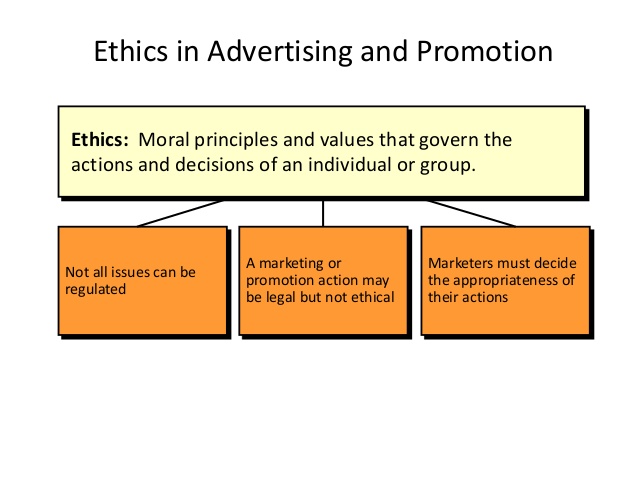
Evaluation:
1. What are advertising media?
2. List five forms of advertising media
3. What are the advantages of internet as an advertising medium over other forms of media?
https://www.slideshare.net/shalu4shalin ... ertising-1
ASSIGNMENT
1. The business of giving information to the public about a product or service is (a) warehousing (b) advertising (c) transport (d) insurance
2. Which of the following is a negative function of advertising? (a) Provides information (b) creates brand loyalty (c) creates employment (d) persuades buyers
3. Which medium of advertising is best when product demonstration is needed? (a) Journals (b) magazines (c) newspapers (d) television
4. Which of these media will you advice a businessman to use in advertising his new soap? (a)journals (b) magazines (c)newspapers (d) television
5. To embark on product advertisement,it is necessary to do all the following except (a)studying the product quality (b)reporting other competitors to the government (c)measuring the prejudice (d)ascertaining customer`s buying habits
6. Which of the following advertising is audiovisual? (a) Posters (b) television (c) radio (d) magazines
7. for an advertised product to capture a large share of the market ,it has to satisfy the following conditions except
(a) create desire for it among the public (b) carry a clear message about its quality (c)arouse people`s interest (d)use only one medium of advertising
8.which medium of advertising could be found along Nigerian road?(a) bill boards (b)newspapers (c)radio (d)sales van
TOPIC: ADVERTISING
CONTENT:
i. Meaning of Advertising
ii.Types of Advertising
iii. Functions of Advertising
iv. Forms of Advertising media:-Radio, Television, Newspapers, Magazines, Handbills, Internet, Bill Boards, etc.
v. Advertising Ethics.
ADVERTISING, TYPES AND FUNCTIONS
MEANING OF ADVERTISING:
Advertising means calling the attention of members of the public (audience) to a product, service or an idea in order to encourage them to buy.

FEATURES OF GOOD ADVERTISING:
i.it must arrest attention
ii.it must convince the prospective to buy
iii.it should create a permanent, good impression of the commodity in the mind of the buyers

TYPES OF ADVERTISING
1. Informative Advertising: This is designed to make members of the public aware of new facts and about what they have not heart of before. This type of advertising is mostly used to call the attention of the audience to the existence of new goods ,products and services in the market.
2.Persuasive Advertising:This calls on the people to buy and use a product or service irrespective of what their attitude may be towards such a product or service.Various devices and well chosen words are used to make people believe in the advertising appeal.It attempts to convince the audience that one`s product is better than the other.
3.Competitive Advertising: This types of advertising seeks to persuade the consumer to use a particular type of product in preference to another.It is mostly to advertise goods that have many substitutions e.g detergents ,toilet-soaps, beer, tooth-pastes,etc.It can used to break through a monopoly.
4. Mass Advertising: Mass advertising takes place when producers of a particular line of goods decide to advertise for the general use of such goods without mentioning a particular brand.
5. Specific Advertising: This directs the appeal on a particular brand of goods or services.
https://www.slideshare.net/KatieTaplin/ ... g-69088207
FUNCTIONS OF ADVERTISING
I.It helps to inform the public (potential consumers) about the availability of new products, services and the continued existence of older ones.
ii.It increases the market share of the company`s product
iii.It informs and educates the consumers about the use of a product or service
iv.Advertising informs people where to obtain goods and services
v.It ensures frequent use of goods and sustains demand
vi.Advertising improves the quality of goods and services
vii.It provides employment opportunities
viii.It enhances the turnover of the firm
ix.It promotes the image of the firm.
Evaluation:
1. Define advertising
2. List four types of advertising
3. List five functions of advertising
LESSON 11
FORMS OF ADVERTISING MEDIA AND ADVERTISING ETHICS
FORMS OF ADVERTISING MEDIA
An advertising medium is a means through which information about goods and services is conveyed to the public or target audience. Advertising media include the following:
a) Television
b) Radio
c) Newspapers
d) Internet
e) Billboards
f) Magazines
g) Cinemas
TELEVISION
The required information that is intended to establish a good image for the business,is often sent as news items through the television in order to serve a very large audience.

Advantages of using Television
The true form and colour of the product can be seen
The method of using the product can be demonstrated
It helps to reach very many audience especially in the urban centres
Disadvantages
It is expensive
Impulse buying may be misleading
Only television owners can be aware of the product
RADIO
There is little doubt that radio is at the reach of every home in Nigeria. It is thus,
an effective medium of advertisement as it can get to the remotest part of the country.

Advantage of using Radio
It has a very wide coverage
It is very cheap to possess
It is durable
It can use alternative power source e.g battery
It is portable
Disadvantages
Advert on radio is usually short
NEWSPAPERS
Newspapers are an important means of advertising one`s goods and services. They are the most used medium of advertisement and are considered cheaper when compared with other means like radio and television.

INTERNET
Internet advertisement is the latest form of advertising in Nigeria and in many parts of the world.It is an electronic form of advertising products.


Advantages of internet
It is used to reach a very large population through its global coverage
It creates global market for the products
Disadvantages
It can be accessed only by those who own computers and are connected to the internet
It can only reach those who are computer literate and are used to access the internet
It can easily be used for fraudulent practices
BILLBOARDS
These are very large and tall sign-posts mounted in strategic locations in cities and towns. It is used to advertise goods.Often,a very large picture of the product or person being advertised is clearly shown on it.

MAGAZINES
These could be used within or outside the organization to inform employees and the public about a company`s activities. Magazines are usually weekly, monthly or quarterly publications and sometimes they cater for different categories of readers. Advertisement in magazines include pictures of the products being advertised, comments on the goods and services.

CINEMAS
Special films are used to arouse consumers ` interest in order to build good image for the organization.

Other Media of Advertising include:
Signals
Trade journals
Posters
Handbills and leaflets
Loudspeakers
Neon light
FACTORS AFFECTING THE CHOICE OF MEDIA
I.The target audience
ii.The age group to which the medium appeals.
iii.The cost of using a particular medium
iv.The number of people reached by the chosen medium
v.The medium or media used by competitors
ADVERTISING ETHICS
Advertising must follow some laid down procedures in order to ensure that consumers are protected.Thus, in line with advertising ethics/culture, advertisers must ensure that:
They are factual with the details of their products.
The reveal any side effects of their products.
They are not deceitful
They state the real prices of their products.
They conform to the standards of advertising a particular product/service.
Service providers conform to the ethics of their professions concerning advertisement.

Evaluation:
1. What are advertising media?
2. List five forms of advertising media
3. What are the advantages of internet as an advertising medium over other forms of media?
https://www.slideshare.net/shalu4shalin ... ertising-1
ASSIGNMENT
1. The business of giving information to the public about a product or service is (a) warehousing (b) advertising (c) transport (d) insurance
2. Which of the following is a negative function of advertising? (a) Provides information (b) creates brand loyalty (c) creates employment (d) persuades buyers
3. Which medium of advertising is best when product demonstration is needed? (a) Journals (b) magazines (c) newspapers (d) television
4. Which of these media will you advice a businessman to use in advertising his new soap? (a)journals (b) magazines (c)newspapers (d) television
5. To embark on product advertisement,it is necessary to do all the following except (a)studying the product quality (b)reporting other competitors to the government (c)measuring the prejudice (d)ascertaining customer`s buying habits
6. Which of the following advertising is audiovisual? (a) Posters (b) television (c) radio (d) magazines
7. for an advertised product to capture a large share of the market ,it has to satisfy the following conditions except
(a) create desire for it among the public (b) carry a clear message about its quality (c)arouse people`s interest (d)use only one medium of advertising
8.which medium of advertising could be found along Nigerian road?(a) bill boards (b)newspapers (c)radio (d)sales van
WEEK 6
LESSON 12
Topic: TRANSPORTATION
CONTENT: 1. Meaning of Transportation
2. Types of Transportation: Road, Air, Rail, Water, etc
MEANING OF TRANSPORTATION, IMPORTANCE OF TRANSPORTATION IN COMMERCE and TYPES OF TRANSPORTATION.
MEANING OF TRANSPORTATION
As an aid to trade, transportation is the process of moving goods and people from one place to another. It is the life-blood of an economy. Without transportation goods produced cannot get to the final consumer and thus, production cannot be complete.

IMPORTANCE OF TRANSPORTATION IN COMMERCE
1. Transportation makes it possible for manufacturers to get raw materials to factories and carry finished goods from factories to their final consumers.
2. It facilitates the movement of persons from one place to another
3. It facilitates the distribution of goods and thus encourages mass production of goods. For example Cocoa produced in Nigeria is transported to other countries, and this increases the production of cocoa in Nigeria.
4. It provides employment for workers within the transport system, thereby helping to improve standard of living.
5. As a life-blood of the economy, it contributes to gross national product and national income.
6. By contributing to national income, on the long run, it gears the nation towards economic development.
TYPES OF TRANSPORTATION
There are five basic types of Transportation. These are
a. Road
b. Rail
c. Water
d. Air
e. Pipeline
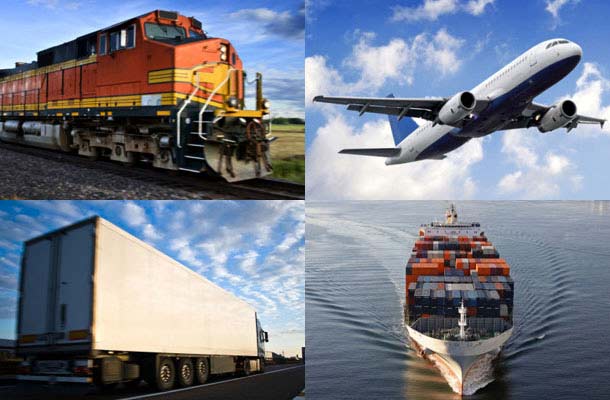
Road Transportation
This is the most popular type of transportation. Here the major means of road transportation are:
a. Motor Vehicles: This includes cars, buses, motor cycles, lorries, trailers and tankers
b. Mechanical means of transportation: Bicycles, carts and wheel-barrow
c. The Use of animals: donkeys, horses, and camels
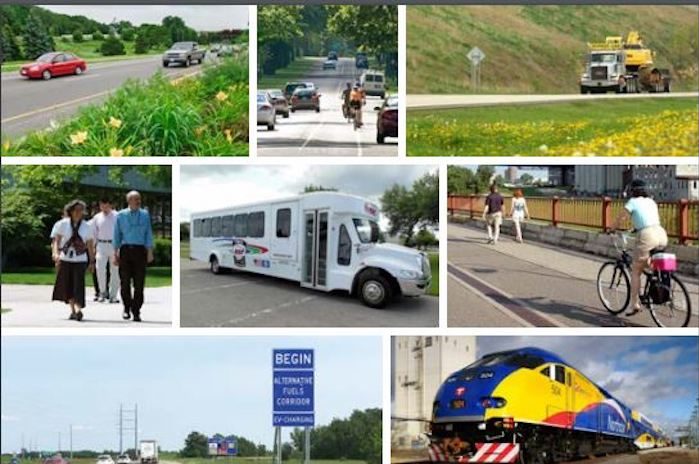
Advantages of Road Transportation
1. This type of transportation can reach remote places and provide door-to-door service in every part of the country.
2. It is the cheapest means of transportation, especially in short distances
3. It is not usually limited by weather condition
4. It is flexible; it does not travel on schedule.
5. It is the most suitable for transporting perishable goods such as vegetables and tomatoes.
Disadvantages of Road Transportation
1. Road transportation usually encounters traffic congestion especially in commercial areas and cities.
2. Road transportation is more prone to accidents than other forms of transportation because of bad roads, and carelessness of operators.
3. Automobiles contribute to air pollution.
4. Motor vehicles cannot carry as much heavy and bulky goods as the train and ship.
5. It is prone to armed robbery attack and car snatching.
RAIL TRANSPORTATION
Rail transportation makes use of trains which always move on schedules. Rail transportation is managed in Nigeria by the Nigerian Railway Corporation. Rail transport is the most suitable where heavy and bulky goods are to be carried over long distances.

Categories of Train
i. Goods train: It carries commodities such as groundnut, cottons, etc.
ii. Passengers trains: they carry people from place to place
Advantages of Rail Transportation
a. Trains carry heavy and bulky goods than motor vehicles.
b. It is cheaper when traveling over a long distance.
c. Accidents are not common occurrences in rail transportation.
d. It does not suffer traffic congestion like motor vehicles
Disadvantages of Rail Transportation
a. It does not provide door-to-door services because it operates on fixed routes and scheduled times
b. It is not suitable for transporting perishable goods.
c. Railways are expensive to construct and the trains are costly to maintain.
a.
LESSON 13
WATER TRANSPORTATION
This is a type of transportation which moves goods and people from one place to another on water. The means of water transportation include:
a. River Transportation: Canoes, boats and steamers carry passengers and goods across big rivers like River Niger or River Benue within the country
b. Ferries Transportation: Here ferries carry passengers and goods across rivers and lagoons usually on short distances.
c. Sea and Ocean Transportation. Here ships are used to carry goods and passengers across oceans and seas. Transportation is usually between two or more countries. Ships that carry passengers are called Passengers liners, while those that carry goods are called Cargo liners.

Advantages of Water Transportation
i. Water Transport is the most suitable and cheapest means of transport for conveying bulky goods such as motor vehicles, heavy industrial machines, etc.
ii. It is the cheapest means of transportation from one country to another.
iii. It is not so prone to accidents –especially the ocean liners, though the ferries and boats do capsize when there is engine failure.
iv. Traffic congestion does not affect water transport.
Disadvantages of Water Transportation
a. Water transportation is slow and time-consuming.
b. It cannot provide door-to-door delivery of goods.
c. It operates on fixed routes therefore it is not a flexible means of transportation.
d. It is not easily accessible to people who are not living near seas, oceans, rivers or lakes
e. Water transportation is usually disturbed by bad weather.
AIR TRANSPORTATION
This is the fastest means of transportation. It makes use of aircraft which could be either helicopter or airplanes. There are two types of aeroplane which are Passengers planes and cargo planes. Cargo planes carry goods only.
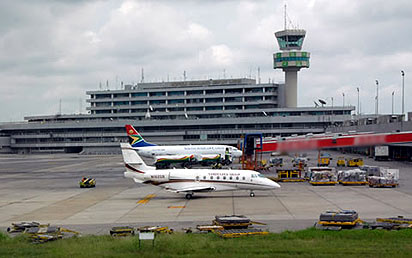
Advantages of Air Transportation
a. It saves time being the quickest means of transportation.
b. Because of its speed, it is suitable for carrying perishable and fragile goods.
c. It is provides a lot of comfort and luxury.
d. Helicopters and special planes are used in rescue mission.
e. Accidents occur less frequently thus it is safer than road transportation.
Disadvantages of Air Transportation
a. It is very expensive in terms of aircraft cost, its maintenance, and construction of airport.
b. The fare of air travel is expensive, low-income earners may not be able to afford such.
c. It is not flexible because it operates on schedule
d. Air transport is not suitable for carrying bulky goods.
e. Though accidents rarely occur, when they do, they are always fatal.
PIPELINE TRANSPORTATION
Pipelines are means of transporting gases and liquids such as water, crude oil, and refined petroleum products from one place to another. These pipes are usually buried underground to reduce damage or vandalism.

Advantages of Pipeline Transportation
a. Pipes are durable materials which can be used for decades.
b. There is usually low risk of contamination of substances transported through pipes
c. Pipelines transport is economical since it has little or no maintenance cost.
d. Road congestion, accidents and destruction of roads, by tankers will considerably reduce by using pipelines.
Disadvantages of Pipelines Transportation
a. Damages to pipelines usually leads to a lot of wastage of the liquid carried.
b. Pipes are prone to vandalisation and because the goods are highly inflammable, it could result to loss of lives and property.
c. The cost of laying pipes is very high.
d. It is difficult to detect and repair damaged pipes.
EVALUATION
Objective Test:
1. Road transport is preferred to others because
a. The fare is the cheapest.
b. It is best for carrying heavy goods.
c. Armed robbers do not go near the vehicles.
d. It is the fastest means.
e. It provides door to door services.
2. Which of these is not a means of road transportation?
a. Okada
b. Donkeys
c. Trailers
d. Ferries
e. Tricycle
3. All of the following are means of water transportation except:
a. Ferries
b. Boats
c. Camels
d. Ships
e. Canoes
4. Transportation performs the following positive functions except:
a. It makes goods and services available in any part of Nigeria
b. It provides jobs for people
c. It is makes goods and services to be expensive
d. It encourages traveling and tourism.
5. The cheapest means of transporting heavy and bulky goods over long distances in Nigeria is by _________
a. Truck
b. Buses
c. Ship
d. Trailer
e. Rail
Essay Test:
1.
a. Explain the term ‘Transportation
b. Mention 3 important reasons why transportation is crucial in business.
2.
a. List the five types of transportation in Nigeria
b. Write two advantages of each
c. Write two disadvantages of each
3. By what means of transportation can the following goods be carried? Give reasons for your answers.
a. Palm produce from Owerri to Lagos.
b. Groundnut from Kano to Lagos.
c. Construction equipment from Ibadan to Kaduna.
d. Some perishable agricultural products from Sokoto to Lagos.
Topic: TRANSPORTATION
CONTENT: 1. Meaning of Transportation
2. Types of Transportation: Road, Air, Rail, Water, etc
MEANING OF TRANSPORTATION, IMPORTANCE OF TRANSPORTATION IN COMMERCE and TYPES OF TRANSPORTATION.
MEANING OF TRANSPORTATION
As an aid to trade, transportation is the process of moving goods and people from one place to another. It is the life-blood of an economy. Without transportation goods produced cannot get to the final consumer and thus, production cannot be complete.

IMPORTANCE OF TRANSPORTATION IN COMMERCE
1. Transportation makes it possible for manufacturers to get raw materials to factories and carry finished goods from factories to their final consumers.
2. It facilitates the movement of persons from one place to another
3. It facilitates the distribution of goods and thus encourages mass production of goods. For example Cocoa produced in Nigeria is transported to other countries, and this increases the production of cocoa in Nigeria.
4. It provides employment for workers within the transport system, thereby helping to improve standard of living.
5. As a life-blood of the economy, it contributes to gross national product and national income.
6. By contributing to national income, on the long run, it gears the nation towards economic development.
TYPES OF TRANSPORTATION
There are five basic types of Transportation. These are
a. Road
b. Rail
c. Water
d. Air
e. Pipeline

Road Transportation
This is the most popular type of transportation. Here the major means of road transportation are:
a. Motor Vehicles: This includes cars, buses, motor cycles, lorries, trailers and tankers
b. Mechanical means of transportation: Bicycles, carts and wheel-barrow
c. The Use of animals: donkeys, horses, and camels

Advantages of Road Transportation
1. This type of transportation can reach remote places and provide door-to-door service in every part of the country.
2. It is the cheapest means of transportation, especially in short distances
3. It is not usually limited by weather condition
4. It is flexible; it does not travel on schedule.
5. It is the most suitable for transporting perishable goods such as vegetables and tomatoes.
Disadvantages of Road Transportation
1. Road transportation usually encounters traffic congestion especially in commercial areas and cities.
2. Road transportation is more prone to accidents than other forms of transportation because of bad roads, and carelessness of operators.
3. Automobiles contribute to air pollution.
4. Motor vehicles cannot carry as much heavy and bulky goods as the train and ship.
5. It is prone to armed robbery attack and car snatching.
RAIL TRANSPORTATION
Rail transportation makes use of trains which always move on schedules. Rail transportation is managed in Nigeria by the Nigerian Railway Corporation. Rail transport is the most suitable where heavy and bulky goods are to be carried over long distances.

Categories of Train
i. Goods train: It carries commodities such as groundnut, cottons, etc.
ii. Passengers trains: they carry people from place to place
Advantages of Rail Transportation
a. Trains carry heavy and bulky goods than motor vehicles.
b. It is cheaper when traveling over a long distance.
c. Accidents are not common occurrences in rail transportation.
d. It does not suffer traffic congestion like motor vehicles
Disadvantages of Rail Transportation
a. It does not provide door-to-door services because it operates on fixed routes and scheduled times
b. It is not suitable for transporting perishable goods.
c. Railways are expensive to construct and the trains are costly to maintain.
a.
LESSON 13
WATER TRANSPORTATION
This is a type of transportation which moves goods and people from one place to another on water. The means of water transportation include:
a. River Transportation: Canoes, boats and steamers carry passengers and goods across big rivers like River Niger or River Benue within the country
b. Ferries Transportation: Here ferries carry passengers and goods across rivers and lagoons usually on short distances.
c. Sea and Ocean Transportation. Here ships are used to carry goods and passengers across oceans and seas. Transportation is usually between two or more countries. Ships that carry passengers are called Passengers liners, while those that carry goods are called Cargo liners.

Advantages of Water Transportation
i. Water Transport is the most suitable and cheapest means of transport for conveying bulky goods such as motor vehicles, heavy industrial machines, etc.
ii. It is the cheapest means of transportation from one country to another.
iii. It is not so prone to accidents –especially the ocean liners, though the ferries and boats do capsize when there is engine failure.
iv. Traffic congestion does not affect water transport.
Disadvantages of Water Transportation
a. Water transportation is slow and time-consuming.
b. It cannot provide door-to-door delivery of goods.
c. It operates on fixed routes therefore it is not a flexible means of transportation.
d. It is not easily accessible to people who are not living near seas, oceans, rivers or lakes
e. Water transportation is usually disturbed by bad weather.
AIR TRANSPORTATION
This is the fastest means of transportation. It makes use of aircraft which could be either helicopter or airplanes. There are two types of aeroplane which are Passengers planes and cargo planes. Cargo planes carry goods only.

Advantages of Air Transportation
a. It saves time being the quickest means of transportation.
b. Because of its speed, it is suitable for carrying perishable and fragile goods.
c. It is provides a lot of comfort and luxury.
d. Helicopters and special planes are used in rescue mission.
e. Accidents occur less frequently thus it is safer than road transportation.
Disadvantages of Air Transportation
a. It is very expensive in terms of aircraft cost, its maintenance, and construction of airport.
b. The fare of air travel is expensive, low-income earners may not be able to afford such.
c. It is not flexible because it operates on schedule
d. Air transport is not suitable for carrying bulky goods.
e. Though accidents rarely occur, when they do, they are always fatal.
PIPELINE TRANSPORTATION
Pipelines are means of transporting gases and liquids such as water, crude oil, and refined petroleum products from one place to another. These pipes are usually buried underground to reduce damage or vandalism.

Advantages of Pipeline Transportation
a. Pipes are durable materials which can be used for decades.
b. There is usually low risk of contamination of substances transported through pipes
c. Pipelines transport is economical since it has little or no maintenance cost.
d. Road congestion, accidents and destruction of roads, by tankers will considerably reduce by using pipelines.
Disadvantages of Pipelines Transportation
a. Damages to pipelines usually leads to a lot of wastage of the liquid carried.
b. Pipes are prone to vandalisation and because the goods are highly inflammable, it could result to loss of lives and property.
c. The cost of laying pipes is very high.
d. It is difficult to detect and repair damaged pipes.
EVALUATION
Objective Test:
1. Road transport is preferred to others because
a. The fare is the cheapest.
b. It is best for carrying heavy goods.
c. Armed robbers do not go near the vehicles.
d. It is the fastest means.
e. It provides door to door services.
2. Which of these is not a means of road transportation?
a. Okada
b. Donkeys
c. Trailers
d. Ferries
e. Tricycle
3. All of the following are means of water transportation except:
a. Ferries
b. Boats
c. Camels
d. Ships
e. Canoes
4. Transportation performs the following positive functions except:
a. It makes goods and services available in any part of Nigeria
b. It provides jobs for people
c. It is makes goods and services to be expensive
d. It encourages traveling and tourism.
5. The cheapest means of transporting heavy and bulky goods over long distances in Nigeria is by _________
a. Truck
b. Buses
c. Ship
d. Trailer
e. Rail
Essay Test:
1.
a. Explain the term ‘Transportation
b. Mention 3 important reasons why transportation is crucial in business.
2.
a. List the five types of transportation in Nigeria
b. Write two advantages of each
c. Write two disadvantages of each
3. By what means of transportation can the following goods be carried? Give reasons for your answers.
a. Palm produce from Owerri to Lagos.
b. Groundnut from Kano to Lagos.
c. Construction equipment from Ibadan to Kaduna.
d. Some perishable agricultural products from Sokoto to Lagos.
WEEK 7
LESSON 14
Topic: COMMUNICATION
CONTENT:
1. Meaning of Communication
2. Means of communication: post, telephone, world-wide.
3. Importance of communication in business.
MEANING OF COMMUNICATION AND TYPES OF COMMUNICATION
MEANING OF COMMUNICATION
Communication can be defined as the giving and receiving of messages or information between two or more parties. It is an aid to trade. For communication to be effective, it must be clearly received, understood and acted upon.
Communication involves the sender, the message being sent and the receiver. This is illustrated below:

Communication is not a one-way affair. The receiver also communicates the sender either directly or indirectly.

TYPES OF COMMUNICATION
There are three types of communication namely:
a. Oral communication: This includes face-to-face discussions, radio transmission, telephone discussions, lectures, etc
b. Written Communication: Examples are writing letters, sending e-mails, report writing, newspapers, magazines, etc.
c. Non-verbal Communication: This can be in form of silence, shaking of the head, sign language (for the deaf), raising your eyebrow, etc.
MEANS OF COMMUNICATION and IMPORTANCE OF COMMUNICATION
MEANS OF COMMUNICATION
Means of communication can be broadly divided into two categories:
a. Traditional means of communication
b. Modern means of communication
Traditional Means of Communication
a. Town Criers: These are used by community leaders to disseminate messages to members of the community.
b. Gun Shots: these are used to announce or welcome important visitors and bid farewell to the dead.
c. Talking drums: these are usually used during ceremonies or festivities. They communicate messages to their hearers.
d. Striking or ringing of bells: This is used to signify the commencement of an event.

b. Modern Means of Communication: these are faster and more effective than traditional means of communication. They include:
a. The Post: This is done through post offices. The agency in charge of this is Nigerian Postal System (NIPOST)
b. Telecommunication: This includes land phones, cell phones (popularly known as GSM –Global System for Mobile Telecommunication)
c. Radio and Television
d. Newspaper, magazine and journal
e. Courier Services
f. Internet services: this includes sending e-mails, e-banking, e-commerce, surfing the net, chatting, etc.
IMPORTANCE OF COMMUNICATION
1. Newspapers, radio and television enables the public to be aware of government policies, programmes, activities and other things happening around the world.
2. It brings about closer contact between the buyer and the seller thus enhancing the efficiency and effectiveness of business operations.
3. It improves commerce by allowing people from different countries to buy and sell, sometimes without having to make physical contact.
4. Communication promotes advertisement which leads to quick sales and enhanced profit.
5. Communication assists in economic development of a country.
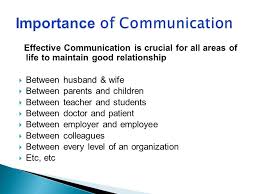
Evaluation:
Objective Test:
a. Communication is important in promoting activities in the following ways except:
a. It leads to increased cost of production
b. It promotes global business transactions through the internet
c. It facilitates quick business contact and speedy delivery of messages to business partners
d. It promotes effective international trade.
b. Post offices in Nigeria are managed by a body called
a. NICON
b. NTA
c. NITEL
d. NIPOST
c. The full meaning of GSM is
a. Global System for Modern Communication
b. Global Style for Mobile Communication
c. Great System for Modern Communication
d. Global System for Mobile Communication
https://www.slideshare.net/drjayeshpati ... s-26090063
Essay Test:
1. a. What is communication?
b. List the different means of communication
c. Itemize four traditional means of communication.
d. Describe the method by which the following messages can be sent.
a. That there will be Town’s meeting in two weeks’ time at the village market square.
b. When a prominent member of the community is to be buried.
C. That morning prayer meeting of a church in the remote village is about to commence
d. A notice to the Village head to represent his village in a meeting in the city.
e Local government Chairman paid a visit to the village
LESSON 15
SERVICES PROVIDED BY COMMUNICATION AGENCIES
CONTENT: 1. Postal and Telegraphic services
2. Telephone services and Internet Services
3. Courier Services
POSTAL AND TELEGRAPHIC SERVICES
The post office is the communication agency responsible for providing postal and telegraphic services. The Government body in charge of activities of the post offices is Nigerian Postal System (NIPOST). The services provided by NIPOST include the posting of the following types of letters

Ordinary Letter:
Letters are means through which an individual or business organization makes contact with other individuals or business organizations through written communication. Letters are the commonest means of communication. It includes such features as:
- The name and address of the person to whom the letter is to be sent, known as the Addressee
- The correct amount of postage stamp
- Sender’s name and address (written at the back of the envelope)
Express Letters:
These are more quickly dispatched letters than ordinary letter. Because of the urgency involved, the charges are higher than that of ordinary letter. When an express letter is delivered, the recipient signs a document as an evidence of delivery. An example is EMS Speedpost provided by NIPOST. EMS stands for Express Mail Service
Registered Letters:
Valuable documents, postal orders and money orders are sent through this means. It is the means used when it becomes very important that a mail must get to the right hand at its destination. A registered letter is affixed with a registration label which bears a serial number.
Parcels:
NIPOST offers parcel delivery services. The parcels must be properly tied to ensure that the contents are intact for delivery. The cost of postage varies according to the mode of posting and weight.
Surface Mail:
Surface mails are delivered by sea. Charges for surface mail vary from time to time but the minimum rate is 150 percent of the standard in land postal rate
Airmail Service:
Through this means NIPOST sends letters and parcels by air to their destinations. Airmail is identified with a blue Airmail label to the left-hand corner envelope or the term ‘Airmal’ written boldly on the same left-hand corner. Airmail services attract a higher postage rate than the surface mail services.
Telegrams and Cables:
Here NIPOST transmits messages on behalf of the sender to a post office nearest to the receiver of the message. The receiving Post office decodes the message and forwards it in a special envelope to the addressee. It is more expensive and its cost depends on the number of words contained in the message.
However, the availability of GSM telecommunication has rendered this medium obsolete.
Post office Box:
This is popularly called P.O. Box. It is a facility provided by NIPOST to individuals or business organizations who wish to receive their letters and parcels before the normal delivery period. Two keys, original and duplicate are given to the owner of the box to enable him access his mails at times convenient to him.

Private Mail Bag:
This is popularly called P.M.B. It is a facility similar to the P.O. Box, with the difference that their owners are given just a key while NIPOST retains the duplicate. NIPOST opens the bag puts in letters and re-locks the bag, which can only be opened by the owner of the box. Private Mail Bag attracts higher fee than Post Office Box.
Redirection of mails:
NIPOST also helps to redirect a letter to a new location if the addressee has changed his location. NIPOST does this without additional charge.
Franking Machine:
NIPOST grants license to individuals and business organizations before can be allowed to use Franking machine. It is best suited where large number of letters are to stamped. Franking machine imprints stamp or frank one each envelope. Messages franked are not posted but are rather bundled together and handed in at specified counter at the post office.
Postal Order:
Postal orders can be purchased at post offices. The buyer orders the Post Office to pay a named person the stated sum of money at another Post office. The buyer fills a form containing the necessary details. The Post office collects a commission for this service called Poundage
However, poster orders are not legal tenders i.e. they cannot be used in place of currency. It is valid for six months.
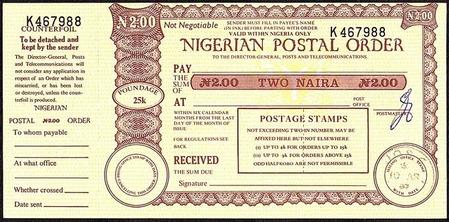
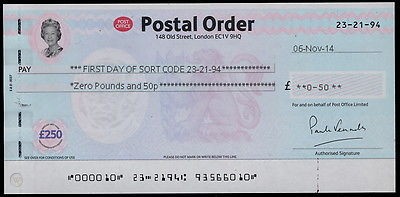
Money Order:
A Money order can be also used to send money to any part of the country. To enjoy this service, you need to pay some money to the post office, fill the form and state some vital information which the recipient will be asked to supply before collecting the money at the other post office
Money orders are safer than postal orders, but they are more expensive because the commission on them is higher. Money order is usually valid for six months.
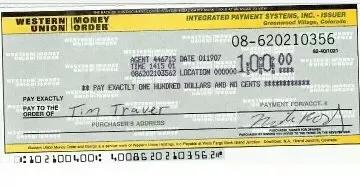
Free Post:
With a license from NIPOST, a customer can dispatch letters using pre-paid envelopes. The customer does not need to affix stamps on the envelope.
TELEPHONE AND INTERNET SERVICES
TELEPHONE SERVICES
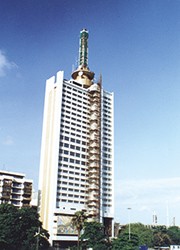
Telephones services are offered by the Nigerian Telecommunication (NITEL). NITEL was established in 1985. Some of the services provided by NITEL are examined below:
Local Calls
These are calls which are made within a city or town. For example, calls within Lagos State are regarded to as local calls
Trunk Calls
These are calls made from one town or city to another. For example calls from Lagos to Kaduna, Yobe, Abeokuta, Ibadan are called Trunk calls. To make trunk calls, a subscriber must first dial the code number of the city before adding real phone numbers. They attract higher charges that local calls.
International Calls
NITEL makes it possible for subscribers to make calls to other countries of the world. International calls attract higher charges and could be done directly or by asking the operator the NITEL switchboard to assist in making the call.
Conference calls
The procedure for conference calls is as follows:
a. Arrange with the operator to get the conferees together on each person’s telephone.
b. The operator informs the conferees that someone (eg. Mr. B) has made a conference call to discuss some issues.
c. The operator connects all the lines
d. The conferees can discuss and reach an agreement without leaving their various locations.
Telephone Directory
This is a book where subscribers can get telephone numbers either of business organizations or individuals. This book is published by NITEL.
Telegram Service
NITEL makes it possible for Nigerians to dispatch telegrams within the country. The sender fills a pre-printed telegram form, after which the clerk determines the amount to be paid. The message is then sent to its destination through a fast electronic device called the telegraph. Any messages sent will be received within forty-eight hours.
Telex Service
A telex system is a fast electronic means of written communication within and outside the country. Messages are sent or received through a telex machine which can also print. Many businessmen prefer telex messages to telegrams because it is faster and more confidential.

Fax Service
Just like telex, fax is a written communication system, except that it is faster than telex. It is operated between two people who have access to fax machine. When the sender feeds the written message into the fax machine, it would automatically be transmitted to the expected receiver. Fax services are commonly used by newspaper houses, banks, insurance companies, etc.
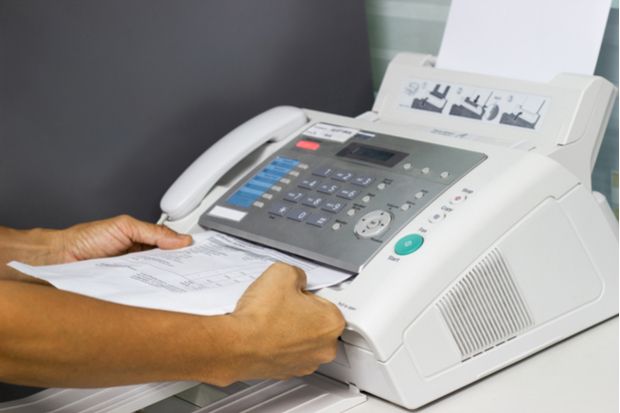
INTERNET SERVICES
The Internet is a system which links together computers all over the word and makes it possible for people to communicate with each other irrespective of their location in the world. Services provided by Internet are as follows:
a. Electronic mail
This is popularly known as e-mail. An e-mail is a communication means by which people send messages to other people in any part of the world. It is faster and more effective than telex or fax messages.
b. World Wide Web (www.examplee.com)
This gives room to vast flow of information across the world. Such world wide webs include Yahoo, Google, Wikipedia, etc.
c. Electronic banking (e-banking)
This provides opportunity for e-payment, electronic transfer of money, etc.
d. Chat room facilities
e. Electronic commerce (e-commerce)
This makes it possible for companies to advertise their goods and services on the internet. Customers also make purchases online and have the goods delivered to them.
f. Online learning
The Global System of Mobile Communication (GSM)
The GSM is the latest and fastest means of communication. It is a wireless system of telephoning, by which you can talk to anybody in any part of the world. It operates through mobile phones. Messages can also be sent through the phones. The major GSM service operators in Nigeria are MTN, Globacom, Airtel, Starcomm, etc.

Courier Services
These are means by which private organizations collect and deliver mails and cargoes quickly and safely. Courier companies must be registered by NIPOST before they can operate. Examples of courier firms in Nigeria are DHL, FEDEX, UPS, TNT, EMS (operated by NIPOST)

EVALUATION
Objective Test:
1. Which of these is not a postal service handled by the NIPOST?
a. E-mail service
b. Airmail service
c. Posting ordinary letters
d. Parcel post
e. Provision of P.M.B.
2. The basic function of courier companies to Nigeria is
a. Carrying and delivering documents to their destinations through the internet
b. Sending documents to their destinations through fax machines
c. Using the GSM services to deliver documents to their destinations
d. Carrying and delivering documents to their destinations speedily and safely.
e. Carrying and delivering documents to their destinations through NIPOST.
3. All the following are the services provided by the internet except:
a. Email
b. Telex service
c. E-banking services
d. Chat-room
e. E-commerce service
4. Telephone users are known as _________
a. Consumers
b. Purchasers
c. Users
d. Subscribers
e. Suppliers
5. Which of the following is not a telephone call?
a. Trunk
b. Local
c. International
d. multinational
Essay Test:
1. Describe the fasted method by which a business can send the following to his business partner
a. A textbook from Macmillan Nigeria Publishers Limited to a student in Deeper Life High School, Kaduna
b. That the business partner should expect him in Abuja within 48 hours
c. A mini-laptop
d. That his customer should let him know the quantity of goods he (the customer) requires and when to send them.
e. A court ruling in Lagos from a lawyer to his client in Owerri
2. What is the difference between P.O. Box and P.M.B? What are their uses?
3. Distinguish between a local call and a trunk call. Outline the procedure for making a conference call.
Topic: COMMUNICATION
CONTENT:
1. Meaning of Communication
2. Means of communication: post, telephone, world-wide.
3. Importance of communication in business.
MEANING OF COMMUNICATION AND TYPES OF COMMUNICATION
MEANING OF COMMUNICATION
Communication can be defined as the giving and receiving of messages or information between two or more parties. It is an aid to trade. For communication to be effective, it must be clearly received, understood and acted upon.
Communication involves the sender, the message being sent and the receiver. This is illustrated below:

Communication is not a one-way affair. The receiver also communicates the sender either directly or indirectly.

TYPES OF COMMUNICATION
There are three types of communication namely:
a. Oral communication: This includes face-to-face discussions, radio transmission, telephone discussions, lectures, etc
b. Written Communication: Examples are writing letters, sending e-mails, report writing, newspapers, magazines, etc.
c. Non-verbal Communication: This can be in form of silence, shaking of the head, sign language (for the deaf), raising your eyebrow, etc.
MEANS OF COMMUNICATION and IMPORTANCE OF COMMUNICATION
MEANS OF COMMUNICATION
Means of communication can be broadly divided into two categories:
a. Traditional means of communication
b. Modern means of communication
Traditional Means of Communication
a. Town Criers: These are used by community leaders to disseminate messages to members of the community.
b. Gun Shots: these are used to announce or welcome important visitors and bid farewell to the dead.
c. Talking drums: these are usually used during ceremonies or festivities. They communicate messages to their hearers.
d. Striking or ringing of bells: This is used to signify the commencement of an event.

b. Modern Means of Communication: these are faster and more effective than traditional means of communication. They include:
a. The Post: This is done through post offices. The agency in charge of this is Nigerian Postal System (NIPOST)
b. Telecommunication: This includes land phones, cell phones (popularly known as GSM –Global System for Mobile Telecommunication)
c. Radio and Television
d. Newspaper, magazine and journal
e. Courier Services
f. Internet services: this includes sending e-mails, e-banking, e-commerce, surfing the net, chatting, etc.
IMPORTANCE OF COMMUNICATION
1. Newspapers, radio and television enables the public to be aware of government policies, programmes, activities and other things happening around the world.
2. It brings about closer contact between the buyer and the seller thus enhancing the efficiency and effectiveness of business operations.
3. It improves commerce by allowing people from different countries to buy and sell, sometimes without having to make physical contact.
4. Communication promotes advertisement which leads to quick sales and enhanced profit.
5. Communication assists in economic development of a country.

Evaluation:
Objective Test:
a. Communication is important in promoting activities in the following ways except:
a. It leads to increased cost of production
b. It promotes global business transactions through the internet
c. It facilitates quick business contact and speedy delivery of messages to business partners
d. It promotes effective international trade.
b. Post offices in Nigeria are managed by a body called
a. NICON
b. NTA
c. NITEL
d. NIPOST
c. The full meaning of GSM is
a. Global System for Modern Communication
b. Global Style for Mobile Communication
c. Great System for Modern Communication
d. Global System for Mobile Communication
https://www.slideshare.net/drjayeshpati ... s-26090063
Essay Test:
1. a. What is communication?
b. List the different means of communication
c. Itemize four traditional means of communication.
d. Describe the method by which the following messages can be sent.
a. That there will be Town’s meeting in two weeks’ time at the village market square.
b. When a prominent member of the community is to be buried.
C. That morning prayer meeting of a church in the remote village is about to commence
d. A notice to the Village head to represent his village in a meeting in the city.
e Local government Chairman paid a visit to the village
LESSON 15
SERVICES PROVIDED BY COMMUNICATION AGENCIES
CONTENT: 1. Postal and Telegraphic services
2. Telephone services and Internet Services
3. Courier Services
POSTAL AND TELEGRAPHIC SERVICES
The post office is the communication agency responsible for providing postal and telegraphic services. The Government body in charge of activities of the post offices is Nigerian Postal System (NIPOST). The services provided by NIPOST include the posting of the following types of letters

Ordinary Letter:
Letters are means through which an individual or business organization makes contact with other individuals or business organizations through written communication. Letters are the commonest means of communication. It includes such features as:
- The name and address of the person to whom the letter is to be sent, known as the Addressee
- The correct amount of postage stamp
- Sender’s name and address (written at the back of the envelope)
Express Letters:
These are more quickly dispatched letters than ordinary letter. Because of the urgency involved, the charges are higher than that of ordinary letter. When an express letter is delivered, the recipient signs a document as an evidence of delivery. An example is EMS Speedpost provided by NIPOST. EMS stands for Express Mail Service
Registered Letters:
Valuable documents, postal orders and money orders are sent through this means. It is the means used when it becomes very important that a mail must get to the right hand at its destination. A registered letter is affixed with a registration label which bears a serial number.
Parcels:
NIPOST offers parcel delivery services. The parcels must be properly tied to ensure that the contents are intact for delivery. The cost of postage varies according to the mode of posting and weight.
Surface Mail:
Surface mails are delivered by sea. Charges for surface mail vary from time to time but the minimum rate is 150 percent of the standard in land postal rate
Airmail Service:
Through this means NIPOST sends letters and parcels by air to their destinations. Airmail is identified with a blue Airmail label to the left-hand corner envelope or the term ‘Airmal’ written boldly on the same left-hand corner. Airmail services attract a higher postage rate than the surface mail services.
Telegrams and Cables:
Here NIPOST transmits messages on behalf of the sender to a post office nearest to the receiver of the message. The receiving Post office decodes the message and forwards it in a special envelope to the addressee. It is more expensive and its cost depends on the number of words contained in the message.
However, the availability of GSM telecommunication has rendered this medium obsolete.
Post office Box:
This is popularly called P.O. Box. It is a facility provided by NIPOST to individuals or business organizations who wish to receive their letters and parcels before the normal delivery period. Two keys, original and duplicate are given to the owner of the box to enable him access his mails at times convenient to him.

Private Mail Bag:
This is popularly called P.M.B. It is a facility similar to the P.O. Box, with the difference that their owners are given just a key while NIPOST retains the duplicate. NIPOST opens the bag puts in letters and re-locks the bag, which can only be opened by the owner of the box. Private Mail Bag attracts higher fee than Post Office Box.
Redirection of mails:
NIPOST also helps to redirect a letter to a new location if the addressee has changed his location. NIPOST does this without additional charge.
Franking Machine:
NIPOST grants license to individuals and business organizations before can be allowed to use Franking machine. It is best suited where large number of letters are to stamped. Franking machine imprints stamp or frank one each envelope. Messages franked are not posted but are rather bundled together and handed in at specified counter at the post office.
Postal Order:
Postal orders can be purchased at post offices. The buyer orders the Post Office to pay a named person the stated sum of money at another Post office. The buyer fills a form containing the necessary details. The Post office collects a commission for this service called Poundage
However, poster orders are not legal tenders i.e. they cannot be used in place of currency. It is valid for six months.


Money Order:
A Money order can be also used to send money to any part of the country. To enjoy this service, you need to pay some money to the post office, fill the form and state some vital information which the recipient will be asked to supply before collecting the money at the other post office
Money orders are safer than postal orders, but they are more expensive because the commission on them is higher. Money order is usually valid for six months.

Free Post:
With a license from NIPOST, a customer can dispatch letters using pre-paid envelopes. The customer does not need to affix stamps on the envelope.
TELEPHONE AND INTERNET SERVICES
TELEPHONE SERVICES

Telephones services are offered by the Nigerian Telecommunication (NITEL). NITEL was established in 1985. Some of the services provided by NITEL are examined below:
Local Calls
These are calls which are made within a city or town. For example, calls within Lagos State are regarded to as local calls
Trunk Calls
These are calls made from one town or city to another. For example calls from Lagos to Kaduna, Yobe, Abeokuta, Ibadan are called Trunk calls. To make trunk calls, a subscriber must first dial the code number of the city before adding real phone numbers. They attract higher charges that local calls.
International Calls
NITEL makes it possible for subscribers to make calls to other countries of the world. International calls attract higher charges and could be done directly or by asking the operator the NITEL switchboard to assist in making the call.
Conference calls
The procedure for conference calls is as follows:
a. Arrange with the operator to get the conferees together on each person’s telephone.
b. The operator informs the conferees that someone (eg. Mr. B) has made a conference call to discuss some issues.
c. The operator connects all the lines
d. The conferees can discuss and reach an agreement without leaving their various locations.
Telephone Directory
This is a book where subscribers can get telephone numbers either of business organizations or individuals. This book is published by NITEL.
Telegram Service
NITEL makes it possible for Nigerians to dispatch telegrams within the country. The sender fills a pre-printed telegram form, after which the clerk determines the amount to be paid. The message is then sent to its destination through a fast electronic device called the telegraph. Any messages sent will be received within forty-eight hours.
Telex Service
A telex system is a fast electronic means of written communication within and outside the country. Messages are sent or received through a telex machine which can also print. Many businessmen prefer telex messages to telegrams because it is faster and more confidential.

Fax Service
Just like telex, fax is a written communication system, except that it is faster than telex. It is operated between two people who have access to fax machine. When the sender feeds the written message into the fax machine, it would automatically be transmitted to the expected receiver. Fax services are commonly used by newspaper houses, banks, insurance companies, etc.

INTERNET SERVICES
The Internet is a system which links together computers all over the word and makes it possible for people to communicate with each other irrespective of their location in the world. Services provided by Internet are as follows:
a. Electronic mail
This is popularly known as e-mail. An e-mail is a communication means by which people send messages to other people in any part of the world. It is faster and more effective than telex or fax messages.
b. World Wide Web (www.examplee.com)
This gives room to vast flow of information across the world. Such world wide webs include Yahoo, Google, Wikipedia, etc.
c. Electronic banking (e-banking)
This provides opportunity for e-payment, electronic transfer of money, etc.
d. Chat room facilities
e. Electronic commerce (e-commerce)
This makes it possible for companies to advertise their goods and services on the internet. Customers also make purchases online and have the goods delivered to them.
f. Online learning
The Global System of Mobile Communication (GSM)
The GSM is the latest and fastest means of communication. It is a wireless system of telephoning, by which you can talk to anybody in any part of the world. It operates through mobile phones. Messages can also be sent through the phones. The major GSM service operators in Nigeria are MTN, Globacom, Airtel, Starcomm, etc.

Courier Services
These are means by which private organizations collect and deliver mails and cargoes quickly and safely. Courier companies must be registered by NIPOST before they can operate. Examples of courier firms in Nigeria are DHL, FEDEX, UPS, TNT, EMS (operated by NIPOST)

EVALUATION
Objective Test:
1. Which of these is not a postal service handled by the NIPOST?
a. E-mail service
b. Airmail service
c. Posting ordinary letters
d. Parcel post
e. Provision of P.M.B.
2. The basic function of courier companies to Nigeria is
a. Carrying and delivering documents to their destinations through the internet
b. Sending documents to their destinations through fax machines
c. Using the GSM services to deliver documents to their destinations
d. Carrying and delivering documents to their destinations speedily and safely.
e. Carrying and delivering documents to their destinations through NIPOST.
3. All the following are the services provided by the internet except:
a. Email
b. Telex service
c. E-banking services
d. Chat-room
e. E-commerce service
4. Telephone users are known as _________
a. Consumers
b. Purchasers
c. Users
d. Subscribers
e. Suppliers
5. Which of the following is not a telephone call?
a. Trunk
b. Local
c. International
d. multinational
Essay Test:
1. Describe the fasted method by which a business can send the following to his business partner
a. A textbook from Macmillan Nigeria Publishers Limited to a student in Deeper Life High School, Kaduna
b. That the business partner should expect him in Abuja within 48 hours
c. A mini-laptop
d. That his customer should let him know the quantity of goods he (the customer) requires and when to send them.
e. A court ruling in Lagos from a lawyer to his client in Owerri
2. What is the difference between P.O. Box and P.M.B? What are their uses?
3. Distinguish between a local call and a trunk call. Outline the procedure for making a conference call.
WEEK 8
LESSON 16
MAIN TOPIC: WAGES AND SALARIES (Revision)
SPECIFIC TOPIC: Role of wages department
REFERENCE BOOKS:
Macmillan JSS3 Business Studies by Awoyokun A.A et al .Pages 6-8
WABP JSS Business Studies 3 by Egbe T. Ehiametalor. Pages 7-10
Spectrum Business Study for JSS3 by Eno L. Inanga and Ebun C.Ojo. Pages 8-10
PERFORMANCE OBJECTIVES: At the end of the lesson, students should be able to:
explain the function of the wages and salaries unit
differentiate between salary and wages
CONTENTS:
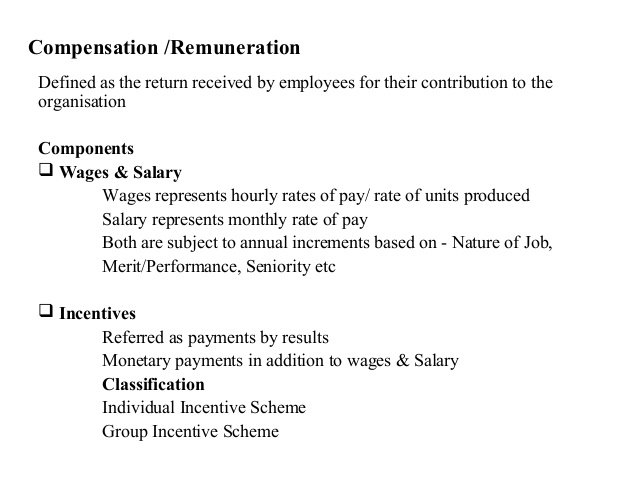
In every organisation, the preparation of the salaries or wages of employees is the responsibility of someone or a group of persons who would collectively be known as the wages department or the salary section of the accounts department.
A wage is a payment made by business organisation for work done or services rendered to it usually by manual workers who are paid either weekly or bi-monthly intervals.
A salary is a payment made for non-manual work done for a minimum number of hours usually 40hours.
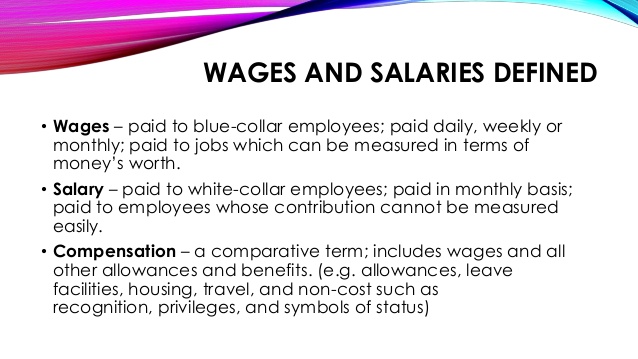
EVALUATION:
Differentiate between salary and wages
Mention five major roles performed by the wages department
HOME-WORK: Mention three documents use in the wages department.
SPECIFIC TOPIC: Documents used in wages department
REFERENCE BOOKS:
Macmillan JSS3 Business Studies by Awoyokun A.A et al .Pages 6-8
WABP JSS Business Studies 3 by Egbe T. Ehiametalor. Pages 7-10
Spectrum Business Study for JSS3 by Eno L. Inanga and Ebun C.Ojo. Pages 8-10
PERFORMANCE OBJECTIVES: At the end of the lesson, students should be able to:
list and explain documents used in the wages department
CONTENTS:Documents used in the wages department include:
Personal wage or salary record card
Individual tax card
Payroll
Pay slip or pay advice
Time card
EVALUATION: Mention five documents used in the wages department.
HOME-WORK: Design your own Pay roll and pay slip.
SPECIFIC TOPIC: Designing documents used in wages department
REFERENCE BOOKS:
Macmillan JSS3 Business Studies by Awoyokun A.A et al .Pages 6-8
WABP JSS Business Studies 3 by Egbe T. Ehiametalor. Pages 7-10
Spectrum Business Study for JSS3 by Eno L. Inanga and Ebun C.Ojo. Pages 8-10
PERFORMANCE OBJECTIVES: At the end of the lesson, students should be able to:
design some of the documents used in wages department.
keep an imprest account
CONTENTS: Petty means small.
An amount of cash kept on hand and used for making small payments is called petty cash.
The person who keeps it is known as the petty cashier.
EVALUATION: Design a pay roll and pay slip for Pen-Write Academy using a computer
HOME-WORK: What are store records?
https://www.slideshare.net/iamlessa/wag ... nistration
MAIN TOPIC: WAGES AND SALARIES (Revision)
SPECIFIC TOPIC: Role of wages department
REFERENCE BOOKS:
Macmillan JSS3 Business Studies by Awoyokun A.A et al .Pages 6-8
WABP JSS Business Studies 3 by Egbe T. Ehiametalor. Pages 7-10
Spectrum Business Study for JSS3 by Eno L. Inanga and Ebun C.Ojo. Pages 8-10
PERFORMANCE OBJECTIVES: At the end of the lesson, students should be able to:
explain the function of the wages and salaries unit
differentiate between salary and wages
CONTENTS:

In every organisation, the preparation of the salaries or wages of employees is the responsibility of someone or a group of persons who would collectively be known as the wages department or the salary section of the accounts department.
A wage is a payment made by business organisation for work done or services rendered to it usually by manual workers who are paid either weekly or bi-monthly intervals.
A salary is a payment made for non-manual work done for a minimum number of hours usually 40hours.

EVALUATION:
Differentiate between salary and wages
Mention five major roles performed by the wages department
HOME-WORK: Mention three documents use in the wages department.
SPECIFIC TOPIC: Documents used in wages department
REFERENCE BOOKS:
Macmillan JSS3 Business Studies by Awoyokun A.A et al .Pages 6-8
WABP JSS Business Studies 3 by Egbe T. Ehiametalor. Pages 7-10
Spectrum Business Study for JSS3 by Eno L. Inanga and Ebun C.Ojo. Pages 8-10
PERFORMANCE OBJECTIVES: At the end of the lesson, students should be able to:
list and explain documents used in the wages department
CONTENTS:Documents used in the wages department include:
Personal wage or salary record card
Individual tax card
Payroll
Pay slip or pay advice
Time card
EVALUATION: Mention five documents used in the wages department.
HOME-WORK: Design your own Pay roll and pay slip.
SPECIFIC TOPIC: Designing documents used in wages department
REFERENCE BOOKS:
Macmillan JSS3 Business Studies by Awoyokun A.A et al .Pages 6-8
WABP JSS Business Studies 3 by Egbe T. Ehiametalor. Pages 7-10
Spectrum Business Study for JSS3 by Eno L. Inanga and Ebun C.Ojo. Pages 8-10
PERFORMANCE OBJECTIVES: At the end of the lesson, students should be able to:
design some of the documents used in wages department.
keep an imprest account
CONTENTS: Petty means small.
An amount of cash kept on hand and used for making small payments is called petty cash.
The person who keeps it is known as the petty cashier.
EVALUATION: Design a pay roll and pay slip for Pen-Write Academy using a computer
HOME-WORK: What are store records?
https://www.slideshare.net/iamlessa/wag ... nistration
WEEK 9
LESSON 17
MAIN TOPIC: STORE RECORDS (Revision)
SPECIFIC TOPIC: Meaning and types
REFERENCE BOOKS:
Macmillan JSS3 Business Studies by Awoyokun A.A et al .Pages 9-13
WABP JSS Business Studies 3 by Egbe T. Ehiametalor. Pages 11-14
Spectrum Business Study for JSS3 by Eno L. Inanga and Ebun C.Ojo. Pages 10-14
PERFORMANCE OBJECTIVES: At the end of the lesson, students should be able to:
meaning of store
meaning of store records
types of store records
CONTENTS:
A store can be defined as a place where goods are kept for future use.
The items may be raw materials, semi-finished goods or finished goods.
STORE RECORDS: This is a detailed account of all items of goods which are kept in the store.
They are documents that enable the organisation determine the movement of goods.
TYPES OF STORE RECORD
Stock record card
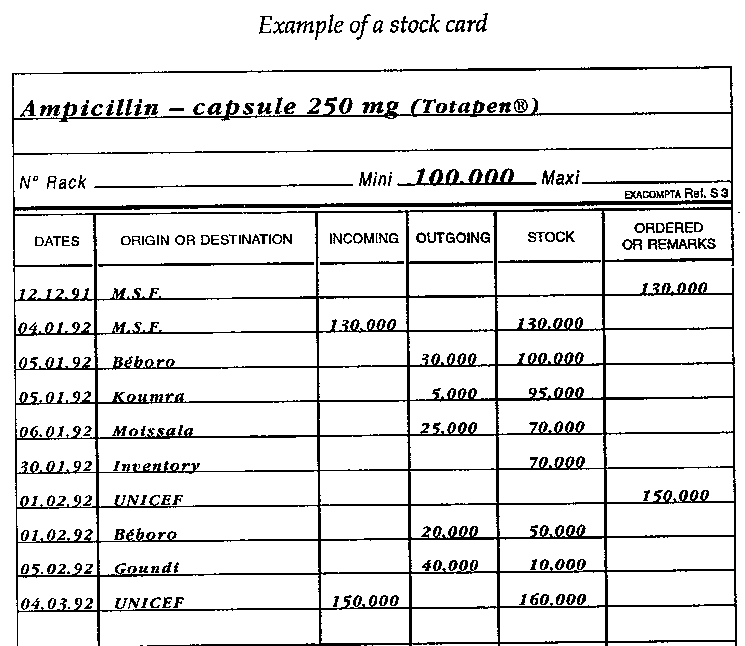
Stock requisition form
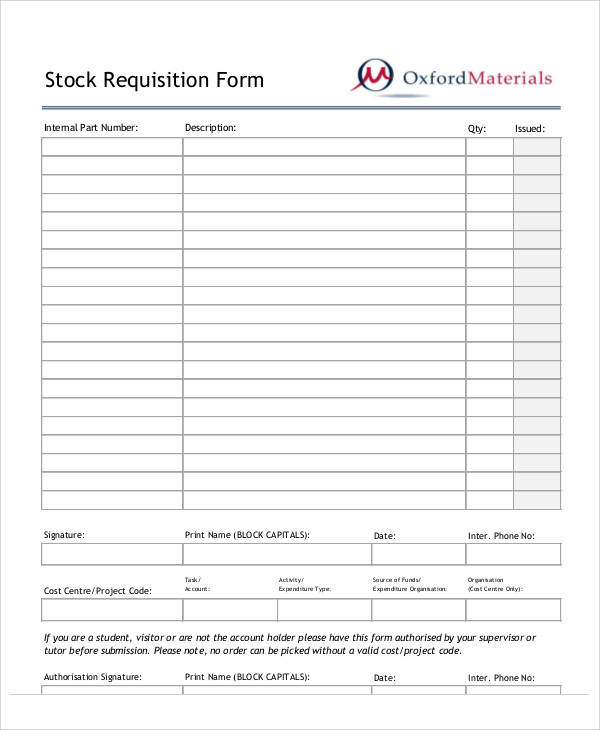
Delivery note or gate pass.
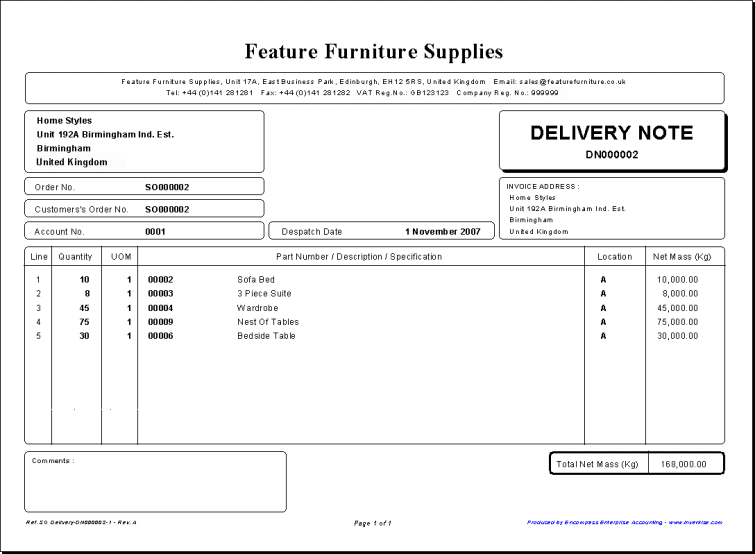
EVALUATION:
What is a store?
What are store records
Mention three type of store records
HOME-WORK: What is store record card?
SPECIFIC TOPIC: Store record card and Stock requisition form
REFERENCE BOOKS:
Macmillan JSS3 Business Studies by Awoyokun A.A et al .Pages 9-13
WABP JSS Business Studies 3 by Egbe T. Ehiametalor. Pages 11-14
Spectrum Business Study for JSS3 by Eno L. Inanga and Ebun C.Ojo. Pages 10-14
PERFORMANCE OBJECTIVES: At the end of the lesson, students should be able to:
explain what a store record is and mention items on a store record card.
explain what a stock requisition form is and mention items on a stock requisition form.
CONTENTS:
STORE RECORD CARD
This provides at a glance detailed information about the quantity of goods supplied or received in the store room with dates.
It must carry the voucher number, name of the supplier, quantity of goods issued, the requisition and the stock balance.
STOCK REQUISITION FORM
These are requests from various department and individuals for supply of stock items required for carrying out their normal duties.
To obtain any item from the store a stock requisition form has to be completed.
It contains information such as: quantity of goods required, description of the goods, suppliers name and address, name signature of store keeper, and name, signature of receiver.
EVALUATION: Write short note on store card and stock requisition form.
HOME-WORK: What is a gate pass?
SPECIFIC TOPIC: Delivery note/ Gate pass
REFERENCE BOOKS:
Macmillan JSS3 Business Studies by Awoyokun A.A et al .Pages 9-13
WABP JSS Business Studies 3 by Egbe T. Ehiametalor. Pages 11-14
Spectrum Business Study for JSS3 by Eno L. Inanga and Ebun C.Ojo. Pages 10-14
PERFORMANCE OBJECTIVES: At the end of the lesson, students should be able to:
explain what a delivery note is and mention items on a delivery note
CONTENTS:
DELIVERY NOTE/ GATE PASS
This is for the use of the security department.
They use the gate pass to check the authorized quantity of goods issued by the store, description of the goods and the authenticity of the person who signed it.
EVALUATION: Design a gate pass using a computer
HOME-WORK: What is stock taking?
further studies
http://www.slideshare.net/verzosaf/effe ... troduction
MAIN TOPIC: STORE RECORDS (Revision)
SPECIFIC TOPIC: Meaning and types
REFERENCE BOOKS:
Macmillan JSS3 Business Studies by Awoyokun A.A et al .Pages 9-13
WABP JSS Business Studies 3 by Egbe T. Ehiametalor. Pages 11-14
Spectrum Business Study for JSS3 by Eno L. Inanga and Ebun C.Ojo. Pages 10-14
PERFORMANCE OBJECTIVES: At the end of the lesson, students should be able to:
meaning of store
meaning of store records
types of store records
CONTENTS:
A store can be defined as a place where goods are kept for future use.
The items may be raw materials, semi-finished goods or finished goods.
STORE RECORDS: This is a detailed account of all items of goods which are kept in the store.
They are documents that enable the organisation determine the movement of goods.
TYPES OF STORE RECORD
Stock record card

Stock requisition form

Delivery note or gate pass.

EVALUATION:
What is a store?
What are store records
Mention three type of store records
HOME-WORK: What is store record card?
SPECIFIC TOPIC: Store record card and Stock requisition form
REFERENCE BOOKS:
Macmillan JSS3 Business Studies by Awoyokun A.A et al .Pages 9-13
WABP JSS Business Studies 3 by Egbe T. Ehiametalor. Pages 11-14
Spectrum Business Study for JSS3 by Eno L. Inanga and Ebun C.Ojo. Pages 10-14
PERFORMANCE OBJECTIVES: At the end of the lesson, students should be able to:
explain what a store record is and mention items on a store record card.
explain what a stock requisition form is and mention items on a stock requisition form.
CONTENTS:
STORE RECORD CARD
This provides at a glance detailed information about the quantity of goods supplied or received in the store room with dates.
It must carry the voucher number, name of the supplier, quantity of goods issued, the requisition and the stock balance.
STOCK REQUISITION FORM
These are requests from various department and individuals for supply of stock items required for carrying out their normal duties.
To obtain any item from the store a stock requisition form has to be completed.
It contains information such as: quantity of goods required, description of the goods, suppliers name and address, name signature of store keeper, and name, signature of receiver.
EVALUATION: Write short note on store card and stock requisition form.
HOME-WORK: What is a gate pass?
SPECIFIC TOPIC: Delivery note/ Gate pass
REFERENCE BOOKS:
Macmillan JSS3 Business Studies by Awoyokun A.A et al .Pages 9-13
WABP JSS Business Studies 3 by Egbe T. Ehiametalor. Pages 11-14
Spectrum Business Study for JSS3 by Eno L. Inanga and Ebun C.Ojo. Pages 10-14
PERFORMANCE OBJECTIVES: At the end of the lesson, students should be able to:
explain what a delivery note is and mention items on a delivery note
CONTENTS:
DELIVERY NOTE/ GATE PASS
This is for the use of the security department.
They use the gate pass to check the authorized quantity of goods issued by the store, description of the goods and the authenticity of the person who signed it.
EVALUATION: Design a gate pass using a computer
HOME-WORK: What is stock taking?
further studies
http://www.slideshare.net/verzosaf/effe ... troduction